NUGENT, HENRY R. (1837-1906). Private, 7th Regiment, New York State Militia, Company D. Nugent was born in New York City and lived there with his parents and siblings at the time of the 1850 census. During the Civil War, he enlisted as a private at New York City on April 19, 1861, and served for 30 days in the 7th Regiment’s Company D. He returned to the same regiment and company when it was reactivated in 1862 as a part of the New York State National Guard, and served for three months. The 1865 New York State census indicates that he lived in Brooklyn and, following in the footsteps of his father, was employed as a sail-maker.
Civil War Bio Search
The New York Tribune reported on July 24, 1871, that Nugent married Kate Stevenson of Brooklyn. As per the 1880 census, he lived with his wife and daughter in Brooklyn and was still working as a sail-maker. The 1890 Veterans Schedule confirms his Civil War service. The 1900 census reports that Nugent lived with his wife and two children in Brooklyn; he was listed as a retired sail-maker. Nugent’s obituary in the Brooklyn Daily Eagle, which confirms his Civil War service, notes that he had lived in Brooklyn for twenty-five years. That obituary also notes that Nugent was a Freemason and a member of the Reformed Church in Brooklyn Heights; members of his Masonic lodge were invited to attend his funeral. He last resided at 23 St. James Place in Brooklyn. He died from a cerebral hemorrhage. Section 200, lot 32547, graves 4 and 5.
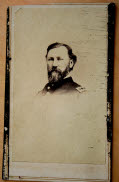
NUKERCK (or NEWKIRK), CHARLES C. (1820-1873). First lieutenant and quartermaster, 51st New York Infantry, Company H. A native of Montgomery, New York, he was most likely the son of Charles Nukerck, a captain in the Eighth Company of the 2nd New York Continental line in the American Revolution and a colonel in the War of 1812. He was christened as Charles Newkirk at the Reformed Dutch Church in Montgomery, New York, on June 10, 1821. The 1850 census and the 1855 New York State census list him as living in Brooklyn with his mother and employed as a merchant.
During the Civil War, Nukerck enlisted at New York City as a private on November 11, 1861, and mustered into the 51st three days later. He rose through the ranks and became a second lieutenant on January 1, 1863, and a first lieutenant and quartermaster on May 1, 1863, effective upon his transfer to the Field and Staff. Nukerck was listed as absent and sick in Cincinnati, Ohio, in August 1863, and returned to active service in September. He was appointed assistant commissary of subsistence, United States Volunteers, at some point before he was discharged on January 27, 1865, at Hancock Station, Virginia. As per the 1870 census, Nukerck was living in New York City and working as a health officer; the 1872 Board of Health listed Nukerck as a clerk in the Bureau of Sanitary Inspection. He died in Manhattan. His death was attributed to nervous prostration. Section 82, lot 4653.

NUNES, HENRY (1830-1872). Corporal, 74th New York Infantry, Company B. Originally from Madeira, Portugal, Nunes enlisted as a corporal at New York City on May 24, 1861, and mustered into the 74th New York on June 27. He was reduced in rank to private on November 1 of that year, and deserted from his regiment on January 1, 1862. The census of 1870 reports that Nunes was married with two young children, worked as a tailor and had a personal estate valued at $300. He was listed as a tailor in the 1872 New York City Directory. According to his death certificate, he was married and worked as a tailor. His last residence was at 164 West 29th Street in Manhattan. His death was attributed to phthisis (tuberculosis). Section 40, lot 4711, grave 115.

NUTHMANN (or NUTTMAN, NUTHMAN), WILLIAM (1839-1865). Private, 84th New York (14th Brooklyn) Infantry, Company E. Nuthmann was born in Prussia. Listed on his soldier record as William Nuttman, he enlisted as a private on April 18, 1861, and mustered into the 14th Brooklyn on May 23. As per his muster roll, Nuthmann was court-martialed for desertion but acquitted of those charges. On May 28, 1864, Nuthmann’s name appeared on the Roll of Honor published in the Brooklyn Daily Eagle that listed the names of those in the 14th Brooklyn who returned home after serving a full term of three years. He mustered out with his company on June 6, 1864, at New York City. He died in Manhattan. As per an article in The New York Times on July 3, 2003, Nuthmann’s headstone, identifying him as Civil War veteran, was among the first discovered by volunteers searching the grounds on behalf of Green-Wood Cemetery’s Civil War Project, resulting in this biography. Section A, lot 8100, grave 291.
OAKES, BURDETT S. (1835-1883). First lieutenant, 13th Regiment, New York State Militia, Company C. Oakes was born in Brooklyn. According to his obituaries in the Brooklyn Daily Eagle and the Brooklyn Standard Union, Oakes had a long-standing interest in military affairs, was one of the founders of the Lexington Guard and also a member of the old American Volunteers, which later became Company C of the 13th Regiment. After enlisting as a first lieutenant at Brooklyn on April 23, 1861, Oakes was commissioned into Company C of the 13th New York State Militia (Heavy Artillery) on May 17, and mustered out after three months at Brooklyn on August 6. On May 28, 1862, he was commissioned into the same regiment and company when it was part of the 13th National Guard, and mustered out after three months at Brooklyn on September 12.
A well-known undertaker in Brooklyn, his name, spelled “oaks” is mentioned in a letter written by Louisa Van Velsor Whitman to her son, Walt Whitman, about the death of her son, Andrew, written on December 4-5, 1863. Mrs. Whitman wrote that she promised to pay the undertaker $52 for his services. A footnote to her letter, which is in the Walt Whitman Archive, indicates that Burdett Oakes was listed as an undertaker at 268 Washington Street in the 1863 Brooklyn Directory.
His obituaries in the Brooklyn Standard Union and the Brooklyn Daily Eagle note that Oakes was the commissary of the 13th Regiment Veteran Association of which he was a founding member; comrades were invited to attend his funeral. As per his death certificate, which incorrectly listed him as “Burdett Soakes,” he was married and employed as an undertaker. His obituary in the New York Tribune indicates that he was the brother-in-law of Chief Clerk Judah B. Voorhees of the Surrogate Court. He last resided at 726 Fulton Street in Brooklyn. His death was attributed to pneumonia. His wife and five children survived him. Section 105, lot 186.
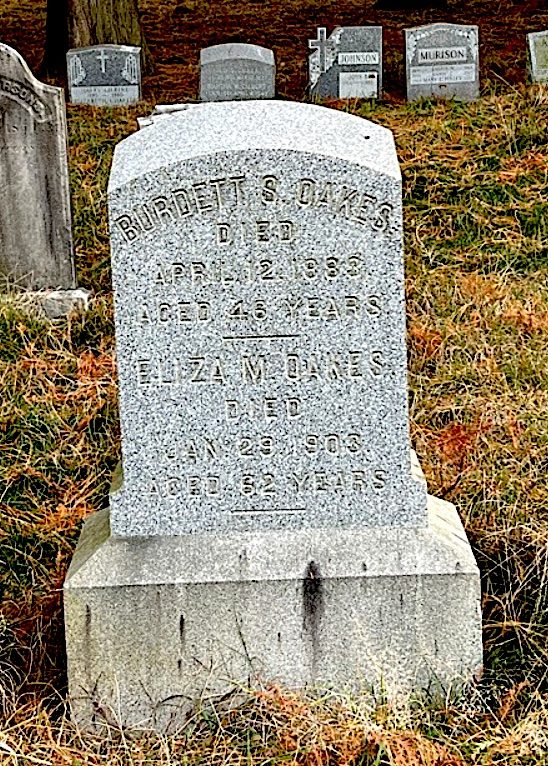
OAKES, FRANCIS JAMES (1839-1919). Sergeant, 1st United States Light Artillery (Regular Army), Battery E. Oakes was born in Boston, Massachusetts. He enlisted in the 1st United States Artillery on November 9, 1858, was promoted to corporal on July 10, 1859, and was present at Fort Sumter, South Carolina, under the command of Major Robert Anderson, when the Civil War began in April 1861. Oakes claimed to have been the first man who fired a gun at Fort Sumter in defense of the Union, a notion that although disputed, was recounted in all of his New York City and Brooklyn newspapers. As per his obituaries in the Brooklyn Daily Eagle and the New York Herald, which recounts his story, Oakes attested:
“As corporal of the guard, it was my duty to relieve the guard stationed on the ramparts, and I was engaged in that duty at the hour when I saw the first shot that was fired from Fort Johnson.
We opened fire in reply at 7 o’clock. Three guns were trained upon the railroad iron battery at Cummings Point. This action was under the direction of Capt. Doubleday, who was the senior in rank. Gun No. 1 was under the command of Sgt. Kearney. Gun No. 2 was under my command, and gun No. 3 was under the command of Corp. Ellerbrook.
When the order was given to fire, we all wanted to be first. These were breech-loading guns. I have always believed that my gun went first, although, of course, that has been disputed by the other gunners. I still claim that I fired the first gun in defense of the Union.”
Oakes was in command of one of the guns that were used to fire the 100-gun salute to the U.S. flag when the troops marched out on April 13, 1861; he narrowly escaped injury in that tribute. He recollected that the cartridges used to fire that salute were made from the flannel underwear of the troops and were placed behind temporary bombproofs inside the ramparts. The men had to be cautious when firing so that they would not hit the excursion boats then in Charleston Harbor. When the powder from the second shot flashed back, it accidentally ignited some of the cartridges, killing one soldier and seriously injuring another.
Oakes was discharged from the 1st Artillery on November 9, 1863. His soldier record notes that he re-enlisted as a private at Washington, D.C., on November 20, 1863, mustered immediately into the United States Army General Service, served as a clerk in the Adjutant General’s Office from which he resigned on June 25, 1865, and was discharged from service on May 1, 1866. He was promoted to sergeant and first sergeant at some point during his service. His obituary notes that he was presented with gold medals by the Chamber of Commerce (pictured below) when he returned to New York City; he lived in Bedford-Stuyvesant, Brooklyn. He is listed as a clerk in the 1870 census; at that time, he lived in Baltimore, Maryland, with his wife, Elizabeth, and daughter, and had a personal estate of $800.
Oakes started his company, which bore his name, in the late 1880s, remaining as its president throughout his lifetime; the Oakes Manufacturing Company in Astoria, New York, made dyewood extracts that are used in the leather and textile industries, where Oakes was well known. Textile Colorist and Converter, in its obituary of Oakes, noted that he developed a specialized product, Crystalline Hematine Paste, which proved very lucrative for his business. The 1888 New York City Directory lists him in the dye business. A Freemason, he was also a member of Lafayette Post #140 of the G.A.R; at the time he mustered into the G.A.R. on June 1, 1888, he listed himself as a merchant who lived at 430 Ditmars Avenue in Long Island City. The 1890 Veterans Schedule confirms his Civil War service in the 1st Artillery. As per his passport application of 1892, he was 5′ 7″ tall with hazel-gray eyes, a high forehead, white hair, bearded chin, small mouth, fair complexion, and round face. The 1894 New York City Directory lists him in the chemicals business in Long Island City.
A bon vivant, the New York World reported on December 29, 1894, that the divorced Oakes took a new wife, the actress Estelle Adelaide Sylvane. The two had married on December 27 at the Church of the Holy Innocents on West 36th Street, near Broadway. At that time, Sylvane was acting as Gertrude in a production of Hamlet; Oakes was thought to be the financial backer of that tour. In that article, it was noted that Oakes was a millionaire whose company had offices in Long Island City, Boston and Philadelphia. The 1900 census lists him as married, living in Manhattan and a chemical manufacturer. In 1901, the Oakes were involved in a divorce suit in which a maid at the Majestic Hotel was unwittingly brought in to testify against Mrs. Oakes to say that she paid no attention to her son and that Mrs. Oakes liked another man; Mrs. Oakes had wanted the maid to defend her allegations that her husband threatened to kill her when he was intoxicated. The 1905 New York State census lists him as head of household, living at the Majestic Hotel and a chemical manufacturer; no wife was listed on that census. In 1907, his application for a pension was approved, certificate 1,145,164. At the time of the 1910 census, he was living with his daughter and her family in Queens and was the president of his manufacturing firm.
On April 13, 1911, the 50th anniversary of the firing on Fort Sumter, the Brooklyn Daily Eagle reported that Oakes regaled relatives and friends with his stories about firing the first shot there; he also said he was the only one still alive who was at that scene; however, about 10 years earlier, on April 5, 1901, the New York Press reported that E.W. Scheibner, a first sergeant of Battery E, who was also at Fort Sumter, attested that Owen McGuire, the gunner of the first gun, had fired the first shot. As per his death certificate, he was married and a manufacturer; the death certificate indicates that he buried in the NY/NJ Crematory but that is incorrect as his obituary notes that he was buried in Green-Wood after a private funeral, and Green-Wood records confirm that. He last lived in an apartment at the Plaza Hotel in New York City. His death was attributed to the ailments of old age. On July 1, 1921, The New York Times reported that Oakes left an estate valued at $999,536 (almost $14 million in 2017 money), and that the assets of his stocks were increased by $226,771. In 1925, Adelaide Oakes, his third wife, applied for and received a widow’s pension, certificate 964,416. Section 175, lot 23693.

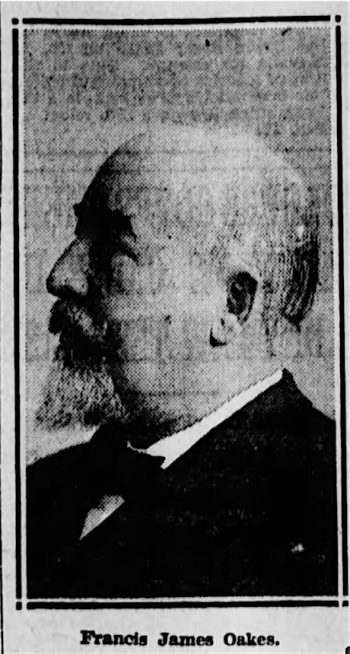
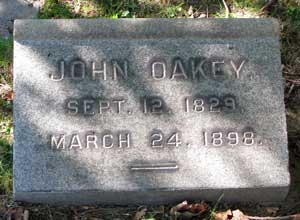
OAKEY, JOHN (1829-1898). Private, 7th Regiment, New York State Militia, Company B. A lifelong resident of Brooklyn, he was born at 133 Sands Street in a house built by his father. A graduate of Erasmus Hall Academy in Flatbush, he played three base ball on the playground that surrounded that school. That game involved players called binders, pitchers, catchers and outers. A player was called out when struck by the ball. The Brooklyn Daily Eagle reported in a story about Oakey in 1894 that Oakey recalled that a fellow player claimed that he didn’t feel the ball when Oakey said that he recorded an out. Oakey then confronted that boy the next time that they played and hit the boy so hard in his back that he fell to the ground; although the player exclaimed that he wasn’t hit, Oakey and the other players knew that he was.
Oakey studied law at Yale, graduated with honors, and after joining the law office of James Humphrey of New York City was admitted to the bar in 1851. He had a long career in Republican politics, stumping for Fremont in New York in 1856 and for Republican candidates nationally in subsequent elections. He enlisted as a private on April 17, 1861, for 30 days, and mustered into Company B which was detailed to defend Washington, D.C. He mustered out on June 3.
In 1866, Oakey was elected to the New York State Assembly as a Republican from a district that was strongly Democratic. Upon re-election he served as Chairman of the Commerce and Navigation Committee. From 1868 to 1873, he was judge advocate with the rank of colonel on the staff of Major General Shaler, First Division, New York National Guard. In 1874, he was counsel for the Brooklyn Police and Excise Departments. He was assistant district attorney under General Catlin for six years and was later an assistant United States attorney for the Eastern District of New York.
According to his obituary in The New York Times, which confirms his Civil War service, Oakey was a popular stump speaker and lecturer who was active in civic life. He was a member of the Mansfield Post #35 of the G.A.R., the Society of Old Brooklynites, and the Brooklyn and Atlantic Yacht Clubs. He also belonged to the Lincoln Club, the Yale Alumni Association of Long Island, and was a founder of the Entre Nous, the Social Literary Union and the Athenian Society. One organization to which he belonged, the Order of the Amaranth, of which he was president, was composed of master masons and their ladies who were urged, through precept and example, to follow the Golden Rule and be mindful of their duties to God, their country and fellow human beings. At the time of his death, he was United States Commissioner for the Eastern District of New York, having been appointed to that position in the summer of 1897.
He died at his residence, 865 Union Street, Brooklyn, where his sudden death was attributed to gastric apoplexy. His wife, Dr. Frances Oakey, applied for a widow’s pension in 1926, application 1,552,888. Oakey was also survived by an eighteen-year-old daughter, Frances. A letter from Oakey to Colonel Emmons Clark regarding the 7th Regiment and the 7th Veterans was offered for sale on eBay in 2020. Section 185, lot 18409.
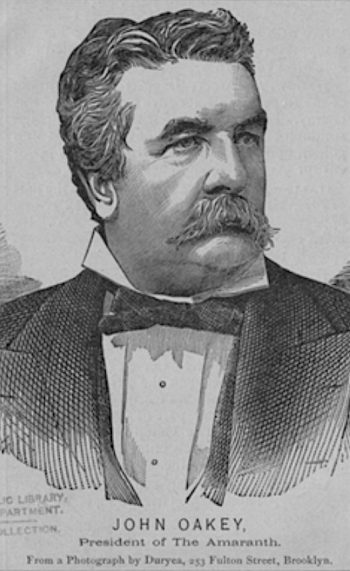
OAKLEY, ALBERT W. (1846-1881). Second sergeant, 84th Regiment, New York State National Guard. Oakley, who was born in New York, served in an unknown company of the 84th Regiment when it was activated for 100 days in 1864. The 1880 census reports that he lived in New York City with his mother and step-father and was employed as a theater manager. As per Oakley’s death certificate, he was a widower. His last address was 148 East 54th Street in Manhattan. Oakley died from an aneurysm. Section 63, lot 23483.
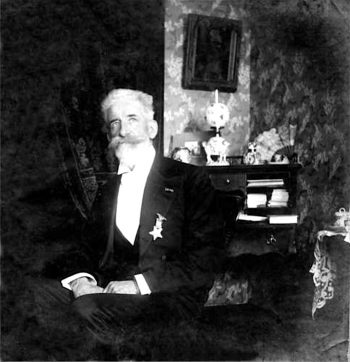
OAKLEY, ALFRED (1840-1892). Private, 7th Regiment, New York State Militia, Company C. Oakley, a New York native, lived in Brooklyn in 1850 with his parents and siblings; the 1850 census reports that his father was a wool merchant whose real estate was valued at $10,000 ($282,000 in 2017 money). As per the 1860 census, Oakley lived in Brooklyn and was employed as a clerk; his personal estate was worth $100. During the Civil War, he was a private in Company C of the 7th Regiment, serving for 30 days in 1861. A year later, when his unit was reactivated, he returned to the same regiment and company, then part of the New York State National Guard, and served for three months. He returned to the 7th again in 1863 for 30 days. His brother, Nelson Horatio Oakley (see), also served in the 7th Regiment.
The New York Evening Post reported on September 25, 1866, that Oakley married Henrietta Ridner at Trinity Chapel in New York City. The census of 1880 indicates that Oakley lived in Union Township in Bergen, New Jersey, with his wife, four children and a servant; he was employed as a broker. On October 3, 1881, the New York Evening Post reported that the citizens of Rutherford, New Jersey, met and nominated Oakley for mayor. Oakley was the first mayor of Rutherford, serving from 1881-1883; his obituary in the New York Tribune notes that he was a Republican and was elected unanimously for two terms. On April 13, 1887, he mustered into Lafayette Post #140 of the G.A.R. and listed his occupation as “comn merchant.” He also belonged to the 7th Veterans Association. The Veterans Census of 1890 confirms his Civil War service in the 7th Regiment. In addition, his obituary in the New York Tribune states that Oakley had been a vestryman at the Grace Church for fifteen years and was a member of the executive committee of the Republican Club in Rutherford, a club organized in June 1892 by well-known citizens of the community including Oakley and another ex-mayor, Luther Shafer. Oakley was also employed as a banker.
As per his obituary in the New York Tribune, Oakley died instantly while walking with a friend from evening services at the Grace Church. According to his obituary in the New York Herald, members of the 7th Veterans were invited to his funeral; it was noted that a train at Chambers Street at 9:30 a.m. would take comrades to his funeral in Rutherford. His obituary also appeared in the Milwaukee Journal Sentinel; his brother, Cyrus Oakley, lived in Chilton, Wisconsin. His last residence was in Rutherford, New Jersey. His death was attributed to rheumatism of the heart. On November 18, 1892, his widow, Henrietta Oakley, petitioned the Surrogate Court in Bergen, New Jersey, for probate of her late husband’s will. An article in the New York Daily Tribune on December 8, 1895, reports about the aftermath of a disastrous fire in 1889 at the site of Rutherford’s Union Club; that article notes that Oakley was a founder of that community’s Chess Club in the 1880s. Section 104, lot 28408.
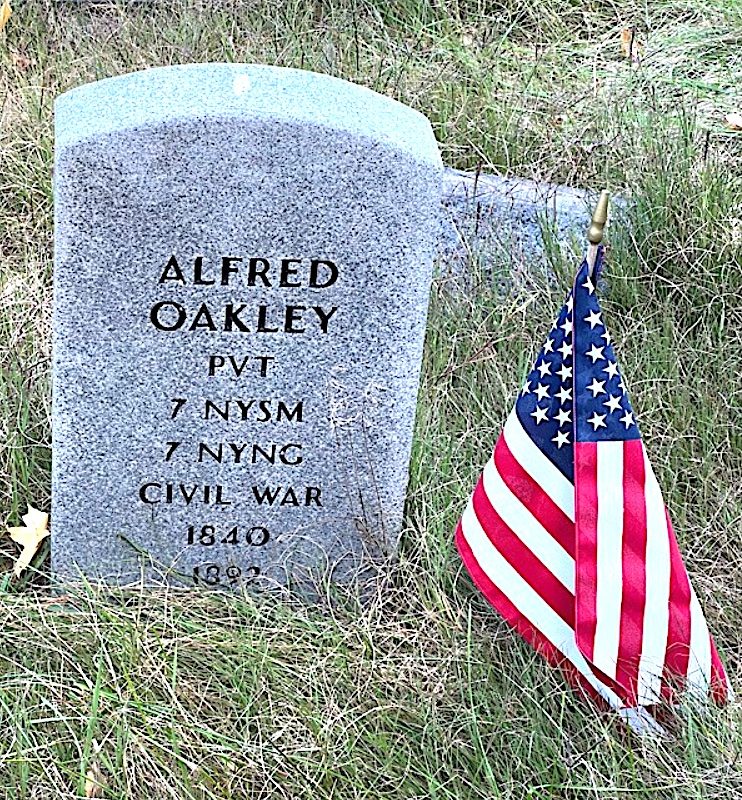
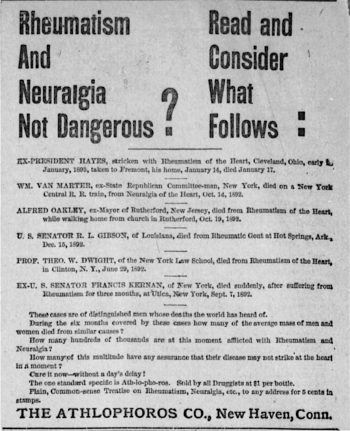
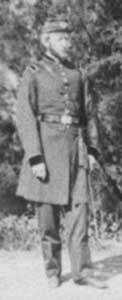
OAKLEY, HENRY (or H.) CRUGER (or CONGER) (1839-1906). First lieutenant, 22nd Regiment, New York State National Guard, Company C. Oakley was a native of New York City and the brother of Walton Oakley (see). As per the 1855 New York State census, he lived with his parents and siblings in New York City; his father, Thomas J. Oakley was the chief judge of the superior court of New York City and owned a brick house valued at $18,000. During the Civil War, he enlisted at New York City as a first lieutenant on May 28, 1862, was commissioned into the 22nd Regiment that day, and mustered out after three months at New York City on September 5.
According to his obituary in The New York Times, which confirms his Civil War service, Oakley joined the Union Club and became a member of the New York Stock Exchange in 1865. The 1884 and 1894 New York State Directories indicate that he was a broker. As head of the firm of Prince & Whiteley, whose office in Manhattan was at 52 Broadway (another office was in New Haven, Connecticut), he was quoted in the Wall Street Daily News on March 5, 1904. In that article, “Opinions Worth Having,” Oakley said: “As a matter of fact, opinions on the present condition of the market can be of little value for the reason that there is practically no market. Business is decidedly flat, and the operators who are paying their office expenses during these times are doing well.”
One source reports that was a member of the G.A.R.’s Colonel James Monroe Post #607 in New York City while his obituary notes that he was a member of the Lafayette Post #140 of that organization. The many organizations to which he belonged include: the Freemasons; the Knickerbocker, Tuxedo, City and Metropolitan Clubs; the New York, Seawanhaka and Richmond County Yacht Clubs; and the Society of Colonial Wars, His death certificate, which lists him as Cruger Oakley, indicates that he was single and a broker. Oakley’s funeral took place at St. Bartholomew’s Church at 44th Street and Madison Avenue in Manhattan. His last residence was 55 Central Park West in Manhattan. Section 90, lot 1022.
OAKLEY, JAMES FLYNN (1819-1904). Private, 71st New York Infantry, Company H. A New Yorker by birth and the son of a prominent New York City family, he was the father of John Oakley (see), who also served during the Civil War. The 1850 and 1860 censuses indicate that he was a halter, an artisan who made horse halters; he was married with four children and lived in Manhattan. According to a descendant, James Oakley lost his wife, Anna Fanning, in 1860, and that might have spurred him to fib about his age and enroll. He enlisted as a private at Olean, New York, on May 12, 1861, and mustered into the 71st on July 21. He was discharged for disability on October 7, 1862, at New York City.
Although the 1874 and 1875 New York City Directories list Oakley as hatter, that is an error—he was still working as a halter. As per the 1880 census, he was living on East 16th Street in Manhattan and working as a stable keeper. Remaining active in military affairs, he mustered into Abraham Lincoln Post #13 of the G.A.R. in May 1883, at which time he reported that he was working as a halter. In 1890, Oakley’s application for an invalid pension was approved, certificate 655,078. At the time of the 1900 census, he was a resident of the Home for Old Men and Aged Couples. His death certificate reports that he was a widower. He last lived in Manhattan at 1060 Amsterdam Avenue, the Home for Old Men and Aged Couples; his obituary in The New York Times indicates that his funeral took place there. His death was attributed to a cerebral apoplexy. Section 45, lot 9614, grave 12.
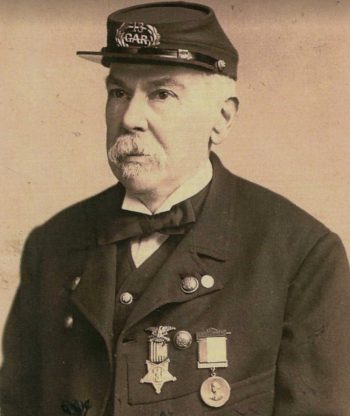
OAKLEY (or OAKLY), JOHN H. (1844-1896). Private, 174th New York Infantry, Company G; 164th New York Infantry, Company G. The son of James Flynn Oakley (see), John Oakley was born in New York City and had three siblings. He is listed as a six-year-old living in New York City on the 1850 census. During the Civil War, he enlisted on October 4, 1862, and mustered into Company G of the 174th New York on October 17. As per his muster roll, which used the spelling “Oakly,” he was a shoemaker who was 5′ 4″ tall with blue eyes, brown hair and a light complexion. He was transferred to Company G of the 164th New York on February 17, 1864, and mustered out on October 12, 1865, at Hart’s Island, New York Harbor.
In 1891, Oakley’s application for an invalid pension was approved, certificate 786,701. On August 19, 1893, Oakley was admitted to the National Home for Disabled Volunteer Soldiers at Togus, Maine, from which he was discharged at his own request on September 16, 1893. On his paperwork for the Soldiers’ Home, he indicated that he was single, suffered from a fistula in the arm as of 1883, and worked as a laborer; at the time of his admission, he listed his father as his closest relative and described himself as 5′ 1¾” tall with gray eyes and hair and a fair complexion. He died in Manhattan. Section 45, lot 9614.
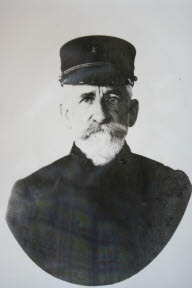
OAKLEY, NELSON HORATIO (1837-1916). Musician, 7th Regiment, New York State Militia, Company C. A native of New York City, he was the brother of Alfred Oakley (see). The 1850 census reports that the Oakleys lived in Brooklyn. During the Civil War, Oakley enlisted at New York City on April 19, 1861, and served 30 days with the 7th Regiment, mustering out on June 3. He also served with the 7th for three months in 1862 from May 25 through September 5 and again in 1863 from June 16 through July 28; his brother served in the same regiment and company during all three of these activations.
On April 6, 1867, the New York World announced Oakley’s marriage to Kate S. Lewis of New York City. The 1870 census indicates that he lived in Rutherford Park, New Jersey, with his wife and two young children, was a merchant, and owned real estate valued at $10,000. The 1870 New York City Directory lists Oakley as a merchant at 21 Beaver Street. On February 11, 1871, The New York Times reported that Nelson H. Oakley had filed for bankruptcy in the Southern District Court of New York. As per the 1880 census, he lived with his wife and two children in Brooklyn and was employed as a bookkeeper; the 1883 Brooklyn Directory listed him as a bookkeeper at 63 Ross Street.
A member of G.A.R.’s Lafayette Post #140, Oakley described himself as a clerk in that post’s sketchbook. In 1894, he applied for and received an invalid pension, certificate 1,093,595. On October 31, 1897, The New York Times reported that Oakley was elected lieutenant of the Third Company of the 7th Regiment Veterans; it was noted that over 300 veterans were present at that annual meeting. The 1900 census reports that he lived in Brooklyn with his wife and daughter and worked as a clerk; the 1910 census indicated that he lived in Brooklyn with his wife and was a clerk for the Gas Company. According to Oakley’s obituary in the New York Herald, veterans of the 7th Regiment were invited to attend his funeral. His obituary in The New York Times noted that he died at St. Luke’s Hospital and that members of the Lafayette Post were requested to attend his funeral in citizens’ dress and badge. He last lived at 254 West 21st Street in Manhattan. He died from myocarditis. Section 163, lot 14788.
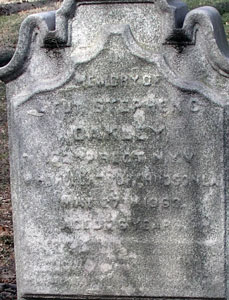
OAKLEY, STEPHEN C. (1837-1863). Captain, 162nd New York Infantry, Companies H and F. After enlisting at New York City as a first lieutenant on September 8, 1862, Oakley was commissioned into Company H of the 162nd that day, transferred to Company F on March 1, 1863, and promoted to captain on March 7, 1863. Critically wounded in battle on May 27, 1863, at Port Hudson, Louisiana, he succumbed there that day. As per his obituary in the New York Tribune, his remains arrived in New York City on March 19, 1864. Oakley’s funeral was held at the Washington Square M.E. Church prior to burial at Green-Wood on March 20, 1864. Section 34, lot 4636.
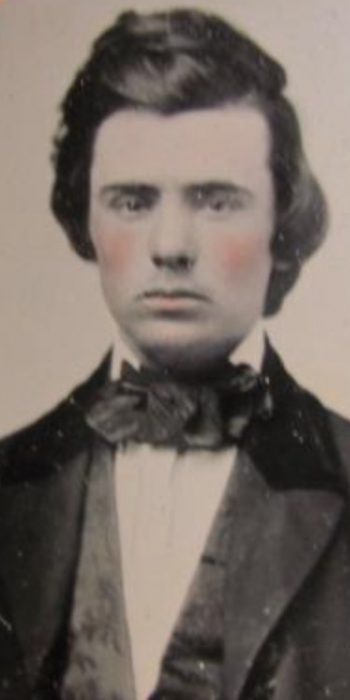
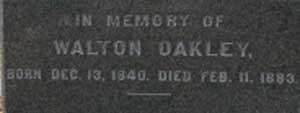
OAKLEY, WALTON (1840-1883). Private, 71st Regiment, New York State Militia, Company F. Oakley, who was born in New York City, was the brother of Cruger Oakley (see). As per the 1855 New York State census, he lived with his parents and siblings in New York City; his father, Thomas Oakley was the chief judge of the superior court of New York City and owned a brick house valued at $18,000. During the Civil War, Walton Oakley served in the 71st Regiment for three months in 1861.
The 1870 census notes that Oakley lived with his mother and siblings in Manhattan; the 1872 New York City Directory lists him as a broker at 112 East 20th Street. In 1883, the New York City Directory lists him as a broker at 62 West 35th Street. His death certificate notes that he was married and lists his occupation as “gentleman.” Oakley’s obituaries in The New York Times and the New York Tribune report that his funeral was at the Calvary Church on Fourth Avenue and 21st Street. He last lived at 62 West 35th Street in Manhattan. He died of albuminuria, a urinary infection. Section 181, lot 6073.
O’BRIEN, FITZ-JAMES (1828-1862). Captain, 90th New York Infantry, Company A; private, 7th Regiment, New York State Militia, Company G. Born in County Limerick, Ireland, O’Brien received a substantial inheritance after his father died when Fitz-James was about twelve. Educated at Trinity College in Dublin, he left for London in about 1849, and then squandered the 8,000 pounds that he inherited. He wrote poems and articles for English and Irish periodicals, including Household Words, edited by Charles Dickens, then came to the United States in 1852 to be near Edgar Allen Poe; he was even referred to as a Celtic Poe.
O’Brien first came to Washington, D.C., then settled in New York City where he frequented Pfaff’s cellar, a Bohemian establishment that attracted the writers of the day, including Walt Whitman. O’Brien was described as of medium height with wavy brown hair, blue eyes, small chin, heavy “cavalry” moustache and a broken nose, which was obtained in a fight. He contributed poems and short stories to New York City newspapers, Vanity Fair and the Atlantic Monthly, was a regular contributor to Harper’s magazine, and became a leading figure in the city’s Bohemian circles. One of his poem’s, The Ballad of the Shamrock, which tells of Irish immigration after the Great Famine, and notes burial of the speaker’s son at Green-Wood, is printed below. The article about his death in The New York Times notes that he was a frequent contributor to that newspaper and was a prolific writer known for charming fancy and exquisite prose. He wrote several plays including A Gentleman from Ireland, which first ran in 1854 and continued in successful revivals until 1895. In 1854, his play, The Sisters, enjoyed a run in New York City. O’Brien also wrote supernatural and science fiction tales. He lived lavishly in spite of his limited writer’s income and was known to be a brawler. Known to befriend those he fought with, it was said that he “never cared for anyone with whom he did not quarrel.”
At the outbreak of the Civil War in 1861, O’Brien joined New York’s famed 7th Regiment in its first activation as a private, and marched off to protect Washington. Arriving in the nation’s capital, he observed, “We are here . . . we all feel somewhat as Mr. Caesar Augustus must have felt when he had crossed the Rubicon.” After his tour, he returned to New York City, where he unsuccessfully tried to organize the McClellan Rifles which was later consolidated into the 90th New York, in which he served as a captain. Joining the staff of Brigadier General Frederick W. Lander in early 1862, he received special and honorable mention for his gallantry at the Battle of Bloomery Gap, Virginia. After improper treatment of a shoulder wound that he had suffered in a skirmish on February 16, 1862, he died of tetanus in Baltimore, Maryland, on April 6, 1862. Before he died, he appointed literary executors stating, “…after I’m dead I may turn out a bigger man than when living.” The Confederate sword that he kept as a trophy of the skirmish at Bloomery Gap was borne on his coffin. After his death, several unsuccessful attempts were made to revive interest in the work of this “neglected genius.” H. L. Mencken would remember him as the only significant artist to die in the Civil War.
The New York Times, in its article about O’Brien’s funeral, published this piece written by O’Brien after his injury, describing his suffering:
I have nothing to write about except myself, a rather one sided subject. Still I must write or die. I havn’t yet told you of my sufferings, and didn’t intent to; but the fit is on me, and I must harrow you a little. I hope to God you never will have to go through what I have experienced, and what I am liable to. For the first week of my wound, nothing but enormous doses of morphine kept me from going crazy with pain. I had to be kept all day in a lazy, half-slumberous condition, in which I felt like a kind of hot-house plant, dozing and living, and that’s all.
It was at this period I conceived that prejudice against my left arm, which has since ripened into hate. I cannot express the feelings with which I now regard that limb. I long to cast it off, to disinherit it, to cut it off with a (sharp) shilling, and thrust it out upon the world to beg. Its hand at present is fit for no higher occupation than to clutch pennies. While highly morphinized, and in a semi-conscious state, I formed the idea that the aggravating limb did not belong to me, but was a vagabond and malicious arm that had attached itself to me for the purpose of preventing my being Commander-in-Chief, which I was to be as soon as I had fought BEAUREGARD in the Colisseum with a trident and a shrimp-net. All my arrangements had been made. Both armies of the Potomac were to assist at the spectacle, when, during any sleep, a rebel spy took away the arm on which I depended for using the shrimp-net, and left me a mutilated member instead. This is the true history of the case, although prejudiced persons might be apt to call it a morphine hallucination.
I left off morphine completely four weeks ago. It was a hard struggle to part with the great consoler, but I gave it up and took to brandy. They gave me a good deal of this in egg-nogg and milk-punch to sustain my really wasted frame. Imagine the 163 pound man you knew, down to about 120, and so weak that the falling of a book startles him as if it were the bursting of a shell. I wish * * * were here to sketch me as I am engineered out of bed to a big chair, with haggard face, spider limbs, and body fairly contracted with the pain of moving. The day after to-morrow I am to have a probe put into the wound and shoved down as far as my elbow, after which they will cut the flesh of the fore-arm open to the bone for six inches in length. So you see I have quite a pleasing prospect before me.
* * * * * * My amusements are not various. I can see from my window a railroad depot and a locomotive; but steam, although a giant, a reformer and an industrial power of vast etceteras, is not strictly cheerful. To-day is, I think, Spring-opening day of the season. The display is very tasteful and elegant. We noticed quite a chaste and novel thing in the way of sunshine, which will no doubt be extensively patronized. A very neat and delicate article of budding elm, trimmed with early blue-birds, attracted much attention, as did also a little chef d’oeuvre, consisting of a pot-pourri of hepaticas, crocuses and snow-drops. Jesting apart, the day is lovely. The sun shines on the distant hills. The singing of the birds comes through my window with a grateful sound as I lie sad, and silent, and suffering. Oh, liberty of motion, health and strength! I never knew what treasures you were till now.
O’Brien’s remains were received at New York City by his company of the 7th Regiment and then brought to the receiving tomb at Green-Wood on April 9, 1862. As per an article on his funeral in The New York Times on April 10, members of his company assembled at the Armory in full fatigue dress with overcoats and white gloves at 11:30 a.m. for the purpose of paying last respects to their comrade. Until that time, O’Brien’s remains had lain in state at the Armory with men assigned to guard his coffin. The article noted that O’Brien’s wound was a calamity that “has deprived the Union of a good officer and literature of a writer who cannot be replaced…” The Times informed its readers that O’Brien had written about the arrival of the 7th Regiment in Washington, D.C., in 1861, from Annapolis and that since that time, 500 troops joined the 7th in the Union’s cause. An Episcopal service was held, calling O’Brien a martyr who joined the staff of General Lander and was praised by General McClellan. The coffin was adorned with his sword and the sword he captured from the rebel officer who wounded him. It was noted that his shattered shoulder blades were extracted, the arm not amputated and his death due to lock-jaw (tetanus). The men of the 7th then escorted the hearse and carriages to Green-Wood’s receiving tomb, case number 180. The regiment’s band played solemn music and three volleys were fired. The article noted that it was expected that friends from “high society in Ireland” would send for the body.
O’Brien’s remains were in the receiving vault until they were interred on November 27, 1874, in a single grave in a public lot. As per Michael Burke, an undertaker who has written about O’Brien for an Irish magazine, this delay of years before burial was not an unusual practice. The un-embalmed body was kept in the above-ground receiving vault until it decomposed naturally, preventing ground-water contamination and conserving land; the bones were then typically placed in an ossuary or in a small plot. An original gravestone, which is no longer there and was not readable in 1925, was initially inscribed, “Here lies the body of that brilliant poet and writer who, whatever his faults may have been, had the saving graces of genius and high principle, as shown by his disinterested devotion to the land of his adoption.” Section 15, lot 17263, grave 1183.
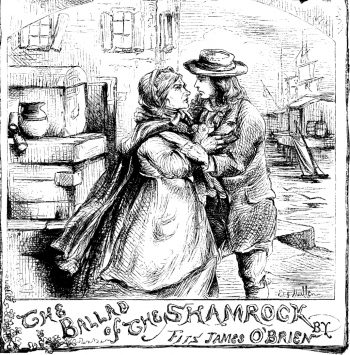

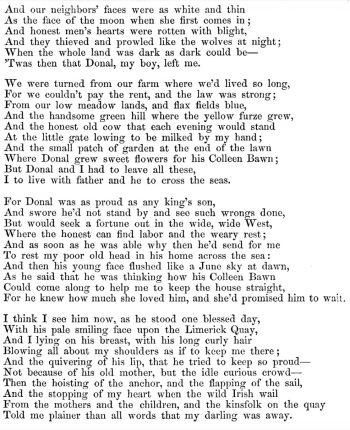


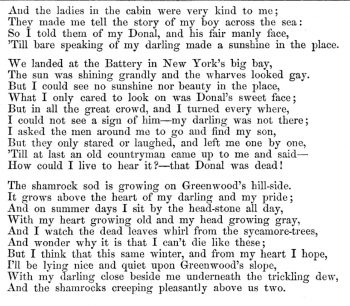
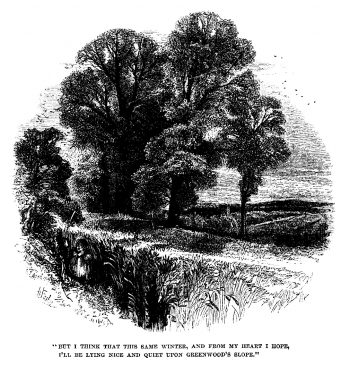
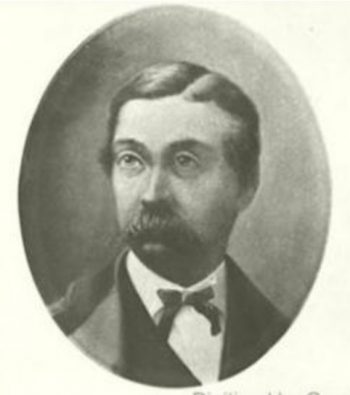
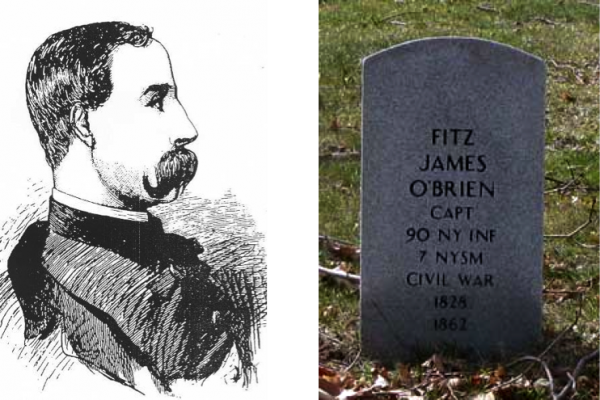


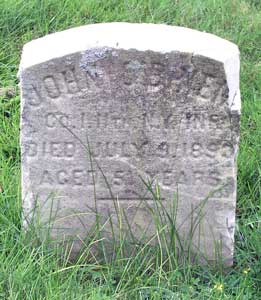
O’BRIEN, JOHN (1840-1893). Private, 11th New York Infantry, Company I. After O’Brien enlisted on April 20, 1861, he mustered into the 11th New York (the Fire Zouaves) on May 7. His muster roll notes that he was also borne on the rolls as George O’Brien. Although his soldier record indicates that he deserted on September 19, 1861, this appears not to have been the case; the United States government issued a headstone for him, and would not have done so if he had been a deserter. As per his obituary in the New York Herald, he died suddenly near his residence on 92nd Street in Astoria, New York. Section 13, lot 19694, grave 387.
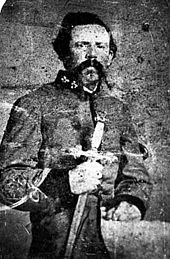
O’BRIEN (or OBRIAN, OBRIEN, BRIEN), JOHN (1847-1922). Landsman, United States Navy. O’Brien’s remains were removed from Green-Wood in April 1943 and re-interred at Gate of Heaven Cemetery in Valhalla, New York. O’Brien was born in England. The 1920 census reports that he immigrated to the United States in 1854; however the 1910 census reports an immigration year of 1859. As per the Westchester W.P.A. (Works Progress Administration) Veterans Project, he enlisted in the United States Navy as a landsman on May 7, 1864, continued his service after the Civil War, and was discharged on July 1, 1867.
At age 47, he lived in the High Bridge section of the Bronx and was a hotel keeper. At that time, he was married with children. At the time of the 1900 census, he was living on Sedgwick Avenue in the Bronx with his wife and children, had been married to Mary for 28 years, was a naturalized citizen and worked as a hotel keeper. The 1910 census shows that he was living with his wife, son and daughter in a home that he mortgaged at 217 Franklin Avenue in Mount Vernon, worked as an upholsterer, and was a veteran of the Union Army; that census states he had been married for 34 years, a number inconsistent with that reported in 1900.
On August 13, 1912, he joined Farnsworth Post #170 of the G.A.R. in Mount Vernon, transferring from Cornelius Vanderbilt Post #136. As per the 1920 census, he was living at 217 Franklin Avenue in Mount Vernon, New York, with his wife, son, daughter and daughter-in-law, was a naturalized citizen, and was working as an operator in a factory. He last lived at 217 Franklin Avenue in Mount Vernon. His death was attributed to apoplexy. O’Brien was originally interred in Section 181/188, lot 18514; his remains were removed from Green-Wood in 1943.
OCHILTREE, THOMAS PECK (1837 or 1839-1902). Colonel by brevet; major and aide-de-camp and assistant adjutant general, 1st Texas Infantry, Company E; Confederate States of America. Ochiltree was buried at Green-Wood within days of his death; he was re-interred at Mount Hope Cemetery in Hastings-on-Hudson, New York, on November 8, 1903. Born in Livingston, Alabama, according to some documents, he grew up in Nacogdoches and Marshall, Texas. Other biographies list his birthplace as Nacogdoches; rather, it appears more likely that his family moved there in 1839 when Ochiltree was an infant.
In 1854-1855, Ochiltree fought the Apache and Comanche Indians when he served in John Walker’s company of Texas Rangers. The Texas Rangers were called upon to protect the frontier where Indian raids were commonplace. Ochiltree learned military strategy and knowledge about Indians during his tenure with the Texas Rangers. He then embarked on his career in government and law, first serving as assistant chief clerk and sergeant at arms of the Texas House of Representatives; he was admitted to the Bar by a special act of the Texas legislature in 1857 despite his young age. He was a lawyer in Marshall and Jefferson, Texas, in practice with his father. He also continued his political life as secretary to the State Democratic Convention in 1859 and delegate to the Democratic National Convention in 1860. In addition, he edited the Star State Jeffersonian, a newspaper in Jefferson.
During the Civil War, Ochiltree first served as a first sergeant in Company E of the 1st Texas Infantry, also known as Hood’s Texas Brigade. His company was raised in Marshall, Texas, in April 1861, and sent to New Orleans, Louisiana, and then to Richmond, Virginia, in July of 1861 for scouting duty. After taking part in some skirmishes, Ochiltree returned to Texas where he was commissioned a lieutenant. By November 1862, Ochiltree was acting as adjutant for the camp of prisoners of war in Tyler, Texas. Shortly after that, he was promoted to captain and served in the Texas Division in Louisiana under the command of Johnny Walker. In April 1864, he was stationed in Camden Road, Arkansas, where he became assistant adjutant general on the staff of General Samuel Bell Maxey. Maxey’s command was comprised of the 1st Brigade (all Texas soldiers) and the 2nd Indian Brigade (Choctaw, Cherokee, Chickasaw and Seminole Indians). With few men and little equipment, Maxey led guerilla-style operations in Arkansas and Oklahoma. Ochiltree continued with Maxey and, at the end of the War, was with him as a colonel in 2nd Texas Cavalry Division. Other biographies note that Ochiltree was promoted to major at some point and was aide-de-camp and assistant adjutant general on the staffs of Confederate Generals Henry Hopkins Sibley, James Longstreet, Thomas Green, Richard Taylor, E. K. Smith, Samuel Bell Maxey and Rains in the Armies of North Virginia, New Mexico, Louisiana, Indian Territory and Arkansas. On April 5, 1865, just four days before Confederate General Robert E. Lee surrendered his Army of Northern Virginia, Ochiltree was brevetted to colonel. On April 6, 1865, he was captured at Sailors Creek, near Appomattox Court House, Virginia, sent to prison camp on Johnson’s Island, Ohio, in Lake Erie, and released when a friend applied upon his behalf to President Andrew Johnson. One biographical piece notes that Ochiltree declared himself a general after Lee’s surrender, tried to continue the war in Texas, and then fled to Europe.
Ochiltree continued both his political and journalistic endeavors after the War. He wrote for the New York News and edited the Houston Daily Telegraph from 1866-1867. Subsequently, he wrote a column entitled “Ranger” for the New York Sportsman. Acting as a representative of the banking and shipping firm, T. H. MacMahon and Company, he traveled to Europe in 1867 to investigate the establishment of a steamship line from Liverpool to Galveston, Texas. Retaining his political interests, he supported Ulysses S. Grant for President in 1868 and promoted the fair treatment of Black citizens. Returning to public service in Texas, he was commissioner of emigration for Texas (1870-1873), United States marshal for the Eastern District of Texas (1874) and an independent representative of the Galveston district in the U.S. House of Representatives (1883-1885). During the years from 1865-1902, Ochiltree made more than 60 trips to Europe advocating for Texas interests including transportation and communication. After his term in Congress, he moved to New York City where he was a lobbyist and was a member of the Camp of Confederate Veterans. He died in Hot Springs, Virginia. His death was attributed to heart disease.
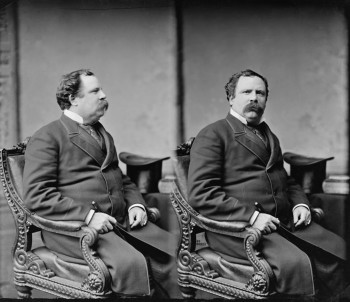
OCHS (or OAKS, OCH, OATES, ROCKS), FRITZ (or FREDRICK, FREDERICK) (1827-1886). Private, 52nd New York, Company F. A German native, the 1850 census indicates that Ochs, spelled “Oaks,” lived in Brooklyn and like many in his family, worked as a shoemaker. The 1855 New York State census also lists him as a shoemaker. During the Civil War, Ochs served as a private in the 52nd New York. Further details of his service are unknown. According to his Draft Registration of July 1863, he worked in a saloon; the Brooklyn Directory of 1863 lists him in the lager beer industry at 309 Atlantic Avenue. The 1865 New York State census and the 1870 census report that he lived in Brooklyn with his wife and children and continued to be in the lager business; the 1875 New York State census shows that he worked at a beer saloon and the 1880 census indicates that he was a lager beer dealer.
An article in the New York Herald on August 25, 1880, noted that Ochs won a victory in his challenge to the Board of Excise Commissioners over the denial of his renewal for the ale and beer license for his saloon; that specific license was repealed on August 16 and replaced with a first class license for the liquor, ale, wine and beer. As a result of Ochs’s challenge, the original licenses were issued under the new interpretation of the Excise statute. On August 26, 1880, The New York Times stated that Ochs and others in the beer business were rejoicing over the decision to re-issue the beer license. The price of the license was raised to $50 and if the licensee sold liquor, which was forbidden under the law, the fee would be raised to $250. The 1883 and 1886 Brooklyn Directories list Ochs in “liquors.” His death certificate notes that he was married and employed as a saloon keeper. As per his obituary in the Brooklyn Daily Eagle, he last lived at 301½ Atlantic Avenue in Brooklyn; friends and relatives were invited to attend his funeral. Section 85, lot 3129, grave 43.
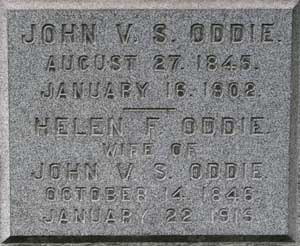
ODDIE, JOHN VAN SCHAICK (1845-1902). Private, 7th Regiment, New York State National Guard, Company H. Oddie, a native of New York City, was born at the Van Schaick mansion at Fifth Avenue and 14th Street. He was the son of William B. Oddie, a landscape artist; his brother, Walter Mason Oddie, was also a landscape painter. The 1855 New York State census reports that Oddie lived with his maternal grandparents in New York City; his mother died in Albany, New York, in 1850. During the Civil War, John V. S. Oddie served for 30 days in 1863 with the 7th Regiment. At age 22, he married Helen Freeman, the daughter of prominent New Yorkers at the Church of the Incarnation in New York City. The New York City Directory for 1867 reports that he was a broker at 31 Broadway. At the time of the census of 1880, he was living in Mamaroneck, New York, with his wife and children and was working as a broker. As per his obituary in the New York Herald, he was broker on Wall Street and for twenty years was a member of the New York Stock Exchange, during which time he made and lost two fortunes.
A lifelong yachtsman, he joined the New York Yacht Club on October 10, 1867, the 32nd member of that association; at that time, the club was housed in Clifton, Staten Island. As per his obituary in the Brooklyn Daily Eagle, Oddie was the secretary of the New York Yacht Club as of 1889 and had become well-known because of his negotiations for the America’s Cup races in the last four years before his death. In addition, he belonged to the Larchmont and Eastern Yacht Clubs and the Manhattan Club of New York. The 1900 census notes that he was living with his wife, two sons and household help in New York City. Oddie’s death certificate lists no occupation and notes that he was married. An article about his funeral in the Brooklyn Daily Eagle notes that it took place at the Church of the Heavenly Rest at Fifth Avenue and 45th Street in Manhattan. About two hundred mourners attended the service including a large contingent from the New York Yacht Club, friends from Wall Street and members of his social circle. His casket was draped in the flag of the New York Yacht Club and floral tributes memorialized his membership in that organization; a floral anchor of white roses was sent by the Larchmont Yacht Club. Twenty carriages followed his casket to Green-Wood for burial. Lewis Cass Ledyard, commodore of the New York Yacht Club, in his memorial tribute said, “…“…For many years the honored secretary of the club, Mr. Oddie possessed in a very unusual degree the love and esteem of his associates, who fully recognized his extraordinary interest in its affairs, his unselfish devotion to its interests and his peculiar pride in its success….” He last lived at 59 West 48th Street in Manhattan. His death was attributed to kidney disease. Section 115, lot 18458, grave 7.
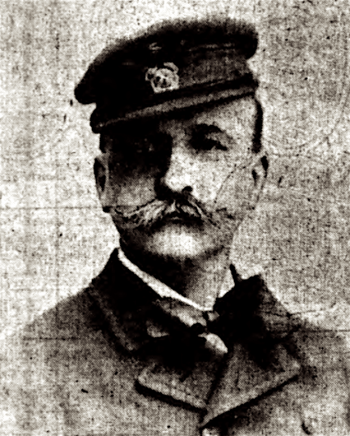
ODELL, JACOB (1840-1866). Private, 62nd New York Infantry, Company K. A native of New York State, Odell was an infant when his father died. According to the 1860 census, he was employed as a clerk. He enlisted as a private at New York City on July 3, 1861, and mustered immediately into the 62nd New York. Further details of his service are unknown. He last lived at 92 Leonard Street in Manhattan where he died from consumption. Section 50, lot 2229, grave 37.
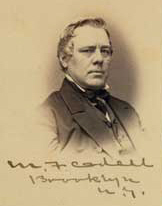
ODELL, MOSES FOWLER (1818-1866). Congressman and friend of President Lincoln. Odell was born in Tarrytown, New York, where his family had historic roots. After moving to Brooklyn as a youngster, he was educated in the public schools and later became a customs agent and public appraiser in New York City. He was also the superintendent of the Sands Street Sunday School in Brooklyn. A Democrat who was respected and popular with his constituents, he proclaimed his loyalty to the Union, the Constitution, and the soldiers who fought in its defense. He was elected to Congress from the area, serving from March 1861-March 1865, and was selected to be a member of the Joint Committee on the Conduct of the War.
A patriot, Odell became a staunch supporter and trusted advisor of President Lincoln. In addition, he was chairman of the Committee on Expenditures in the Department of the Treasury from 1861-1863. A June 14, 1862, article in Harper’s Weekly, highlighted that he was friend of the soldiers, cared deeply about their comfort, and helped minister to the sick and wounded from the 14th Brooklyn who came to Washington, D.C., after the Battle of Bull Run, Virginia. In 1865, he was appointed as a Navy agent in New York City, a position he held until his death. G.A.R. Post #443 in Brooklyn was named in his honor. His last residence was 86 Orange Street, Brooklyn. Section 55, lot 16652.

ODELL, THOMAS BOYCE (1842-1902). Major by brevet; captain, 80th Infantry, United States Colored Troops (USCT), Company A. A native of New York, Odell served in the 8th Regiment, Corps d’Afrique, later known as the 80th USCT. He mustered into the 8th Regiment’s Company A as a second lieutenant on December 22, 1863, and was promoted to first lieutenant on August 14, 1865. He was brevetted to major of United States Volunteers on March 13, 1865, “for faithful and meritorious services during the War.” Odell was subsequently promoted to captain of the 80th on March 17, 1866, and mustered out the following year on March 1, 1867. At the time of his death, caused by tuberculosis, his address was 16 East 97th Street in Manhattan. In 1902, his widow, Naomie Odell, was granted a pension, certificate 544,694. He was interred at Green-Wood on November 30, 1912. His name is displayed on the African American Civil War Memorial in Washington, D.C., plaque C-87. Section 73, lot 1807.
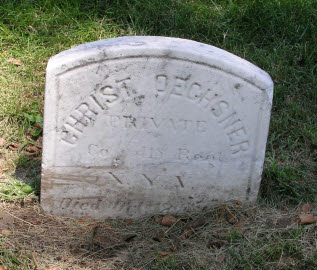
OECHSNER, CHRISTIAN (1835-1891). Musician, 41st New York Infantry, Band; 1st Connecticut Heavy Artillery, Companies I and A; Connecticut Volunteer Band. Born in Germany, Oechsner enlisted as a musician and mustered into the 41st New York on June 26, 1861, at New York City. On June 30, 1862, he was discharged at Middletown, Virginia. A resident of New London, Connecticut, he re-enlisted as a private on November 4, 1862, and immediately mustered into Company I of the 1st Connecticut Heavy Artillery. On December 16, 1862, he was promoted to sergeant and was transferred intra-regimentally to Company A on February 7, 1863. Oechsner was transferred to the Connecticut Volunteer Band, also called the Brigade Band, U.S. Volunteers, on April 4, 1863, with a simultaneous promotion to musician. He mustered out on September 25, 1865.
Oechsner became a naturalized citizen in 1868. According to the 1870 census, he was living in Manhattan with his wife and three children, was working as musician, and had personal property valued at $500. In 1890, his application for an invalid pension was approved, certificate 905,275. He last lived at 111 Noble Street in Brooklyn. His death was caused by cystitis. Marie Oechsner, who is interred with him, applied for and received a widow’s pension in 1891, certificate 361,301. His veteran’s headstone was ordered from Gross Brothers in Lee, Massachusetts, in 1891, and installed soon thereafter. Section 144, lot 27796.
OEHL, NICHOLAS (or NICOLAUS) (1821-1879). Second class musician, 45th New York Infantry, Band. Oehl, who was born in Andernach, Prussia (Germany), was given the birth name Johannes Nicolaus. As per Presbyterian Church Records, he married Louise Schlachte at the First German Presbyterian Church in New York City on April 30, 1853. The 1860 census reports that he was living in New York City with his wife and children, worked as a musician and had a personal estate valued at $1,000. Lloyd’s Minstrels, his troupe, performed at the Musical Fund Ball as advertised in the Philadelphia Inquirer on February 28, 1861. (Minstrel shows, which were popular from the mid-19th century to well into the 20th century, featured performers depicting “blackness” through exaggerated costumes and blackface make-up, supposedly for comedic effect, but relying on racist derision and stereotyping at its core.) On April 1, 1861, the New York Tribune listed him among the all stars in the minstrel show at Niblo’s Saloon. Lloyd’s Minstrels, which was considered a first class organization, lost much of its business in May 1861, because Alvin Lloyd, the manager, owned a Southern publication, the Steamboat Guide, which was filled with his secessionist rants; the troupe disbanded on June 6, 1861, as the Civil War began.
During the Civil War, Oehl enlisted as a musician at New York City on September 25, 1861, and mustered into the band of the 45th New York three days later. He mustered out of service on June 26, 1862, at Middleton, Virginia. At some point, he re-enlisted and rejoined the same regiment as a second class musician. Further details of that second enrollment are not known. Oehl became a naturalized citizen on October 16, 1866; at that time, he lived at 355 Broome Street in Manhattan. The New York City Directories for 1867 and 1879 list him as a musician. His last address was 171 Mott Street in Manhattan. His death was caused by phthisis, Section 13, lot 12879.
OERTLE, EDWARD (1842-1933). Private, 20th New York Infantry, Company H. A New York City native, Oertle lived with his parents and siblings in New York City, as per the 1850 census; his father was a jeweler. The 1860 census reports that Edward was a draftsman. After he enlisted at New York City as a private on August 16, 1861, he mustered into the 20th New York eight days later. His muster roll reports that he was in arrest in April 1863, tried by general court-martial for mutiny and misbehavior before the enemy, found guilty and sentenced to be dishonorably discharged. Ultimately, he was restored to duty and ordered to be honorably mustered out; he was discharged from military service on June 1, 1863, at New York City. His obituaries in the Brooklyn Daily Eagle and the Long Island Daily Press tell a more embellished story of his Civil War service, most likely given to the newspapers by someone who had heard the exaggerated information from Oertle. As per his obituary in the Brooklyn Daily Eagle, he participated at First Bull Run, Virginia, a battle in July 1861, which predates his enlistment in the 20th New York. Both obituaries report that he was wounded in the leg at the Battle of Antietam, Maryland, then fought at the Battle of Gettysburg in July 1863, remained to the end of the conflict and was at the siege of Petersburg and the fall of Richmond, Virginia. Being that his military and pension records indicate that he was discharged on June 1, 1863, it is not possible that he fought at either Gettysburg or the siege of Petersburg; no record confirms his injury at Antietam.
At the time of the 1870 census, Oertle lived in New York City with his wife and two young children and worked in a brass moulding factory. The 1880 census indicates that the family, now with six children, had moved to Brooklyn; he worked in gas fixtures. In 1885, he joined the Stephenson Post #669 of the G.A.R.; in the sketchbook, he listed the same service dates that appear on his soldier record, noted that he lived at 64 Adelphi Street in Brooklyn and worked in a brass factory. The Brooklyn City Directories for 1886 and 1891 list him as a brass finisher. In 1893, his application for an invalid pension was approved, certificate 1,119,019. On December 17, 1899, the Brooklyn Daily Eagle reported that Oertle was elected delegate to the department encampment from the Stephenson Post. He was also an active member of Brooklyn City Post #233 of the G.A.R. The 1910 census incorrectly states that he was born in Germany and indicates that he was a blue printer in a photo gallery; by the time of the 1920 census, he was living with his daughter and son-in-law. Both of Oertle’s obituaries note that he was a draftsman at the Brooklyn Navy Yard from after the Civil War until his retirement in 1911; this information does not match census, Brooklyn Directory or G.A.R. records. His death certificate notes that he was a widower and a retired draftsman. He last lived with his daughter at 9063 206th Street in Queens. His death was attributed to “cardio vascular renal.” Section 128, lot 31502, grave 5.
OGDEN, MORTIMER C. (1832-1903). Captain, 23rd Regiment, New York State National Guard, Company D. Ogden was born in Middletown, New York. He relocated to New York City at about age nineteen and became a partner in the Russell & Erwin Manufacturing Company. On October 16, 1854, he married Amelia Hertle Bell in Middletown, New York. According to the 1890 Veterans Census, he served as a captain in the 23rd New York State National Guard for three months during the Civil War. His obituaries in the Brooklyn Daily Eagle and in a professional publication, Iron Age, note that Ogden was one of the original members of the “famous 23rd Regiment,” being associated with the regiment in 1861, and was its second captain for several years.
In civilian life, he was prominent in the hardware trade and its professional organizations. The 1865 New York State census reports that he lived in Manhattan with his wife and child and was a merchant; the 1870 census lists him living in Brooklyn and working as a hardware dealer. The Brooklyn Daily Eagle reported on November 2, 1877, that Ogden was the Republican candidate for County Treasurer; it is unclear if he won but that it unlikely because the article noted that few Republicans ran for any office and that old Republicans would find it difficult “to recognize which is their ticket.” His obituaries report that for the last twenty-five years of his life, Ogden was president of the Eagle Rock Company, one of the oldest stock corporations in Connecticut and was simultaneously the president of the Southington Cutlery Company. Among the organizations to which he belonged were the Hardware Club and the Hamilton Club; he was a charter member and served on the board of governors of the Hardware Club. In addition, he was an administrator of the Long Island Savings Bank for three years and was on the board of many philanthropic organizations. Remaining active in military affairs, he was the first colonel of the Uniformed Veteran Battalion of the 23rd Regiment and president of the 23rd Regiment Mutual Benefit Association for five or six years. As per his passport application of 1889, he was a manufacturer who lived at 38 Monroe Place in Brooklyn. At that time, he was 5′ 7½” tall with blue eyes, Roman nose, brown hair, brunette complexion, high forehead and medium mouth. The 1895 Brooklyn Directory lists him in hardware and the 1900 census reports that he lived in Brooklyn and was a merchant.
Ogden’s death certificate reports that he was married and was a merchant. According to his obituaries in the New York Tribune and the Brooklyn Daily Eagle, he was a member of the board of trustees of Plymouth Church in Brooklyn and had been president of that board. As per his obituary in the New York Herald, members of the Veteran Association of Company D of the 23rd Regiment were invited to his funeral. His obituary in The Iron Age (January 1904) , written by his colleagues from the Hardware Club, reflected on many of the personal aspects of Odgen’s character: energy, integrity, patriotism, and a deep interest in religion and benevolence. That piece noted that, “…He possessed a rare capacity for work, was devoted to the duties of any trust committed to his charge, and adhered unalterably to right and noble principles….These characteristics, coupled with a courteous, dignified bearing, made him a fine type of the Christian gentleman.” His last residence was 38 Monroe Place, Brooklyn. His death was attributed to a series of strokes in the last weeks of his life. On January 4, 2018, the Wall Street Journal reported that Ogden’s refurbished townhouse “with Jared Kushner’s Touch” was listed for sale by the Kushner family business for $11.4 million; Jared Kushner, who stepped down from his family’s business in 2017, is the son-in-law of President Donald Trump. Section P, lot 25525, graves 12 and 13.
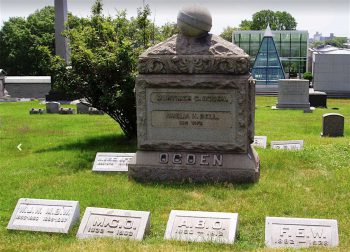
OGDEN, WILLIS LORD (1843-1918). Sergeant major, 23rd Regiment, New York State National Guard, Company A; corporal, 13th Regiment, New York State Militia, Company G. Born in Philadelphia, Ogden’s family moved to Brooklyn when he was about nine years old. The New York State census of 1855 reports that he was living in Brooklyn with his parents and siblings. In 1856, he entered the Brooklyn Polytechnic Institute but left to enter the business world when he was fifteen. During the Civil War, Ogden served as a private with the 13th Regiment for three months in 1861. During those months, his regiment was stationed at Annapolis, Fort McHenry and Baltimore, Maryland. He re-enlisted at Brooklyn as a corporal on May 28, 1862, mustered into the same regiment and company then part of the National Guard, served at Norfolk and Suffolk, Virginia, and mustered out at Brooklyn after three months on September 12. In 1863, he served for 30 days with the 23rd New York National Guard’s Company A as a sergeant major, serving at Harrisburg and Gettysburg.
After his discharge, he returned to the business world where he headed the firm of Willis L. Ogden & Co., manufacturers of woolens. On June 1, 1870, he married Ellen Louisa Smith, the daughter of Cyrus P. Smith, the first mayor of Brooklyn. Remaining interested in military affairs, Ogden was elected captain of the 23rd Regiment, New York State National Guard, in 1872, and lieutenant colonel in 1878; he resigned from the National Guard in 1881. The New York State census of 1875 reports that he was living in Brooklyn with his wife and children and was a clothing merchant. The Veterans Schedule of 1890 confirms his Civil War service. As per the 1900 and 1910 censuses, he lived on Pierrepont Street in Brooklyn and was a wholesale wool merchant; the 1906 Brooklyn Directory lists his wool business as being located at 729 Broadway in Manhattan.
A renowned educator, philanthropist, financier and public servant, Ogden was active in Brooklyn’s cultural and business communities. When the old Academy of Music was destroyed in a fire, he was one of the first to join an association to provide for a new Brooklyn Academy of Music and he was made chair of the board of directors. The other board members said of him, “If it had not been for Colonel Ogden, we would not have had the Academy.” A Republican, he was a member of the Citizens Union and an advocate for “clean government.” As chairman of the Committee of Seventy, he favored the nomination of Seth Low as mayor of Brooklyn and later as mayor of Greater New York; Ogden was Civil Service Commissioner to Brooklyn Mayor Seth Low and was made president of the Municipal Civil Service Commission by Mayor Low in 1902, at a time when civil service reform was badly need in New York City. In the political realm, he also headed a committee to alleviate transit problems at the Manhattan terminus of the Brooklyn Bridge. In addition, he was director of the Brooklyn Savings Bank (where his brother-in-law, Bryan Smith, was the president) and Packer Collegiate Institute, and president of the Brooklyn Academy of Music. His obituary in the Brooklyn Daily Eagle, which confirms his Civil War service, notes that Ogden was also a trustee of the Brooklyn Trust Company, the Brooklyn Society for the Prevention of Cruelty to Children and the Brooklyn Y.M.C.A. and Y.W.C.A.; he was also a member of the Brooklyn Institute, the Hamilton Club, the Merchants Central Club and did charitable work for the Home for Consumptives. The Ogdens were members of the First Presbyterian Church in Brooklyn Heights.
An article about Ogden’s funeral in the Brooklyn Standard Union noted that services were held at the aforementioned church where his casket was draped in a large American flag. A contingent from the 23rd Regiment Veteran Association and the 23rd National Guard attended the funeral. The reverend of the church said of the deceased, “There was something that distinguished Colonel Ogden from other men. He was an example of unselfish brotherhood. His comradeship was wonderful. He was a man who had a great desire to help, to uplift the world, and his one thought was to help the other man.” Ogden last resided at 73 Pierrepont Street in Brooklyn. His death was caused by nephritis. When his last will and testament was brought to Kings County Surrogate Court on August 14, 1918, Ogden’s personal property exceeded $10,000; his four daughters, his church and other organizations were named as beneficiaries. On November 20, 1921, his children donated a Tiffany window in their parents’ honor to the First Presbyterian Church. The window pictures the Ausable River in the Adirondacks where the Ogdens spent their summers. Section G, lot 34215.
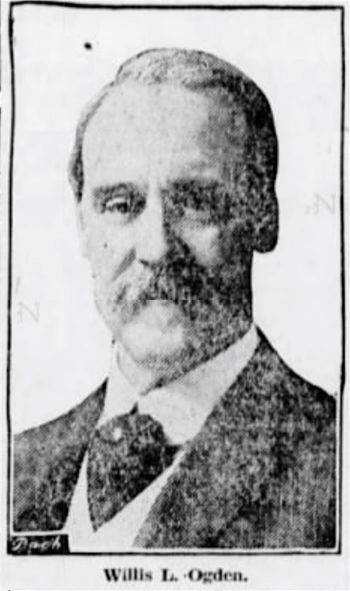
OGILVIE, JR., ROBERT (1845-1876). Private, 170th New York Infantry, Company B. Originally from Scotland, Ogilvie’s family immigrated to the United States in 1847, departing from Liverpool, England, aboard the Hottinguer. After enlisting as a private at Brooklyn on February 1, 1864, he mustered into the 170th New York that same day. According to his muster roll, he was a clerk who was 5′ 8″ tall with black eyes, black hair and a fair complexion. His muster roll indicates that he was detached to Division Headquarters in February 1865, and was absent on furlough when his company mustered out.
The census of 1870 notes that Ogilvie lived in Brooklyn and was a clerk in a law office. On November 10, 1874, the Brooklyn Standard Union reported that Ogilvie was appointed to fill the position of clerk by Justice Elliot in the Fourth District Court. That article, which confirms Ogilvie’s Civil War service, notes that his regiment was part of the Second Army Corps under Major General Winfield Hancock until the surrender of Confederate General Robert E. Lee. Subsequently, Ogilvie was hired by the United States Sanitary Commission to prosecute claims for pensions and bounties without incurring expenses for the claimants. He then studied law before his court appointment. The article noted that he was gentlemanly in manners and appearance and was destined to serve the public well. The 1876 Brooklyn Directory lists him as a law clerk.
As per his obituary in the Brooklyn Standard Union, Ogilvie had traveled to Florida to restore his health but that journey did not result in any improvement. His death certificate notes that he was single and worked as a clerk in the Justice’s Court; that document incorrectly reports that he was born in the United States. The New York Times reported that Ogilvie’s funeral took place at the Reformed Church at Kent Street in Greenpoint, Brooklyn; friends and family were invited to attend. His last address was 112 Guernsey Street, Brooklyn. His death was attributed to phthisis pulmonalis (tuberculosis). When Ogilvie’s will was probated in Kings County Surrogate Court on December 29, 1876, his father, who bore the same name and who resided in Jersey City, New Jersey, was listed as his heir; his estate was valued at about $1,000. Section P, lot 34851, grave 3.
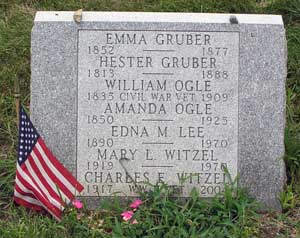
OGLE, WILLIAM (1835-1909). Sergeant, 79th New York Infantry, Companies G, A, B, and D. Born in County Meath, Ireland, Ogle became a United States citizen in 1856. A public carman by profession, 5′ 8″, with dark complexion, black hair and hazel eyes, he enlisted as a private at New York City on September 9, 1862, and mustered into Company G of the 79th New York on that date. On August 31, 1863, he was temporarily assigned to the provost guard at the headquarters of the 9th Army Corps, and records of December 31, 1863, and February 29, 1864, show him still detached to the 9th at Knoxville, Tennessee.
Ogle’s military career involved many intra-regimental promotions and transfers. On May 31, 1864, he was transferred to Company A, then transferred again to Company B when he was promoted to corporal on September 23, 1864. He became a sergeant on December 1, 1864, effective upon his transfer to Company D. After being reduced to ranks (private) on March 24, 1865, he was promoted to sergeant on May 1, 1865, and mustered out on May 30, 1865, at Alexandria, Virginia.
In 1897, his application for an invalid pension was granted (having been previously rejected) because he suffered from rheumatism and varicose veins, certificate 950,847. His first wife, Sophia Ogle, died of major depression-induced anorexia in 1888 and is buried at Green-Wood. His last residence was 68 Monroe Street, Hoboken, New Jersey. The cause of his death was bronchitis. His widow and second wife, Amanda Gruber Ogle, whose brothers Abel and John Gruber (see) also served in the Civil War, received a pension in 1909, certificate 689,228, and is interred with him. Section 15, lot 17263, grave 1999.
O’GRADY, WILLIAM LOUIS DILLON (1840-1923). Second lieutenant, 88th New York Infantry, Companies C and B. A native of Bangalore, India, he was baptized there on May 22, 1841, about a month after his birth. His father, Richard Walter O’Grady, was a major in the British Army there. As per the Indian News and Chronicle of Eastern Affairs on August 30, 1856, Major O’Grady was tried by European court-martial at Secunderabad, India, on May 20, 1856, for conduct unbecoming an officer and using “unjustified and scurrilous” language by referring to his colonel as “a damned old jackass” at the mess hall; O’Grady was found guilty, sentenced to a severe reprimand and assigned to unspecified duty with another corps. However, despite this conviction, Richard O’Grady was brevetted to lieutenant-colonel of Her Majesty’s Indian Military Forces in September 1863. Before immigrating to the United States, William O’Grady served as a second lieutenant in the British Royal Marines as of April 14, 1859. But he soon immigrated to the United States: the year of his immigration to the United States is uncertain, with the 1900 and 1910 census reporting 1860 and The New York Times reporting 1861.
During the Civil War, William O’Grady enlisted as a private at New York City on December 7, 1861, and mustered into the 88th New York, part of Meagher’s Irish Brigade, on that date. O’Grady noted in later years that about one third of the 88th were former British soldiers, veterans of the Crimean War and the Indian Mutiny. As per his pension records, he was wounded in the left breast and left shoulder at the Battle of Antietam, Maryland, on or about September 17, 1862, and was treated at a United States General Hospital in Baltimore, Maryland, for about seven weeks. He rose to the rank of corporal, and was wounded in action at Fredericksburg, Virginia, by a shell fragment to the right hip, on December 13, 1862; he was treated by the surgeon but not hospitalized. His promotion to second lieutenant on December 5, 1863, became effective upon his transfer to Company B on December 13. O’Grady was discharged for disability on March 9, 1864. When O’Grady’s pension was “re-rated” in 1887, the paperwork of the surgeon of the 88th was presented. R. A. Powell, that surgeon, wrote on March 5, 1864, that O’Grady was “laboring under myopia (a near sightedness), which prevents him from performing the duties of an officer, more particularly at night. From this cause he has been unable to perform any picket duty, and, in consequence thereof, he is, in my opinion, unfit for duty. I do further declare my belief that he will never be able to perform the duties of an officer.” As per his obituary and other articles in the Brooklyn Daily Eagle, which confirm his Civil War service, he was a captain in the 88th and was wounded in service; it is unclear why he was referred to as captain– he was not promoted to that rank.
His obituary in The New York Times, which also confirms his Civil War service, notes he returned to India after the War. On March 2, 1867, he married his first wife, Emily Sophia Gerrard, in Cochin, India. There was some controversy during his last year in India; the Madras Gazette reported in 1870 that he was an inhabitant there at the Victoria Hotel, was unemployed and had filed a petition of insolvency, and he was involved in the purchase and sale of rubies. The Times further reported that O’Grady returned to New York in 1869, and was on the staff of the Times, the New York Herald and then managing editor of the Old New York Mail. On October 4, 1871, O’Grady became a naturalized citizen. O’Grady’s application for an invalid pension was granted in December 1871, certificate 211,682. His additional paperwork to the pension bureau on July 27, 1880, and archived by the Department of Interior, notes that he had worked for the Bank of Madras in several locales in India, and, because of disabilities sustained in the Civil War, was unable to do manual labor, and had suffered from liver complaints, which were treated in India, that might have been a result of his service. He also testified that he “had to give up a lucrative situation in the East Indies on account of wounds.” A subsequent review, dated July 17, 1886, established that his disability was 5/8. On July 19, 1887, his case was reviewed again on appeal. The referees concluded that O’Grady only noted his gunshot wounds in his 1871 application and did not make claims about his eyesight until 1880.
Politically active, O’Grady, as per an article in the World on August 2, 1872, was secretary of the Irish Brigade Officers’ Association and was at the Greeley for President headquarters anticipating election results. Sadly, his first wife died at age 25 on February 4, 1873. The 1880 census reported that he lived in Brooklyn and was a journalist. The 1888 Brooklyn Directory reports that he was an editor at 96 Maiden Lane who lived at Sumner Avenue in Brooklyn. According to the 1900 census, O’Grady lived at 1425 46th Street in Brooklyn; he was listed as an engineer. More sadness entered his life, as reported in the Morning Telegraph of April 3, 1900: he had returned to New York City from Richmond, Virginia, where he went to investigate the lynching of his son, Walter O’Grady, by a frenzied mob in Emporia, Virginia (incorrectly identified as Emporia, Kansas, in the article’s headline); a Black man, Brandt Cotton, was lynched at the same time. O’Grady refused to look at or identify the body in Emporia saying, “It is not my son.” That same article also quotes Claude O’Grady, William’s son by his second wife, and the half-brother of Walter. Claude O’Grady notes that the family had relatives in Ireland and England and that it was possible that either his half-brother or his father could have succeeded to an Irish peerage and that his father would succeed to the title of estates in Limerick County. That incident proved extremely troubling to the O’Grady family: many descendants had no idea that this tragedy had happened.
The Brooklyn Daily Eagle indicated that after his newspaper work, he was an attaché of the City Clerk’s office of Brooklyn. His work at that position was marked by several controversial incidents. On July 16, 1885, the Brooklyn Daily Eagle reported that O’Grady, cashier at the Bureau of Water Rates, was suspended by Commissioner Fleeman because O’Grady got in trouble with the registrar; O’Grady tried to bring the case to Mayor Seth Low, but Low refused to review it. Another article on July 21, 1885, referred to O’Grady as “the obnoxious ex-cashier of the Water Bureau.” Ultimately, on October 6, 1885, Commissioner Fleeman concluded that there was nothing in O’Grady’s charges against Registrar McLaughlin and that O’Grady remained in suspense and could be employed elsewhere in the department; six days later, the Civil Service Commission heard the case and reinstated O’Grady to his position but the case was still in flux a month later as reported in the New York Herald on November 10, 1885.
As reported in the Brooklyn Standard Union on October 18, 1876, William O’Grady painted a picture that was displayed in response to Thomas Nast’s cartoon, “Hold the Fort”; O’Grady was identified as a Minute Man of the Seventh Ward. Remaining active in military life, O’Grady was a member of Lloyd Aspinwall Post #600 of the G.A.R. as of 1908, and the Military Institute. His G.A.R. sketchbook for the aforementioned post notes that he had previously belonged to Rankin Post #10. On August 24, 1890, the New York Herald referred to Major O’Grady of the Rankin Post, sporting a green sprig in his hat, as among 100 comrades at Brooklyn City Hall for a flag ceremony. On November 8, 1895, the Brooklyn Daily Eagle reported that O’Grady called for an investigation into a project initiated in 1889 calling for records of Brooklyn soldiers and sailors; apparently accounting had to be made about the moneys appropriated for that project. He was an aide-de-camp in Rankin Post in 1905. He was living on 46th Street in Brooklyn at the time of the 1905 New York State census and the 1910 census and was working as a clerk in the City Clerk’s office.
On February 26, 1908, the Brooklyn Daily Eagle reported that O’Grady represented Meagher’s Irish Brigade at a celebration commemorating the Battle of Fredericksburg hosted by the Catholic War Veterans Benevolent and Memorial Legion. In addition, he was a Freemason. The 1912 New York City Directory reports that he was a clerk at 11 City Hall and lived at 455 Ft. Washington in Manhattan; as per the 1915 New York State census, he lived in Manhattan and was a document clerk. At the time of the 1920 census, he lived on Park Avenue in Plainfield, New Jersey. His death certificate notes that he was married and worked as a clerk. His last residence was 745 Riverside Drive in Manhattan. He died from chronic nephritis. He was survived by a son, Claude O’Grady, an editor for the Washington Post, and four daughters. Minnie O’Grady, his second wife, applied for and received a widow’s pension in 1923, certificate 936,951. Section 180, lot 17359, grave 3.
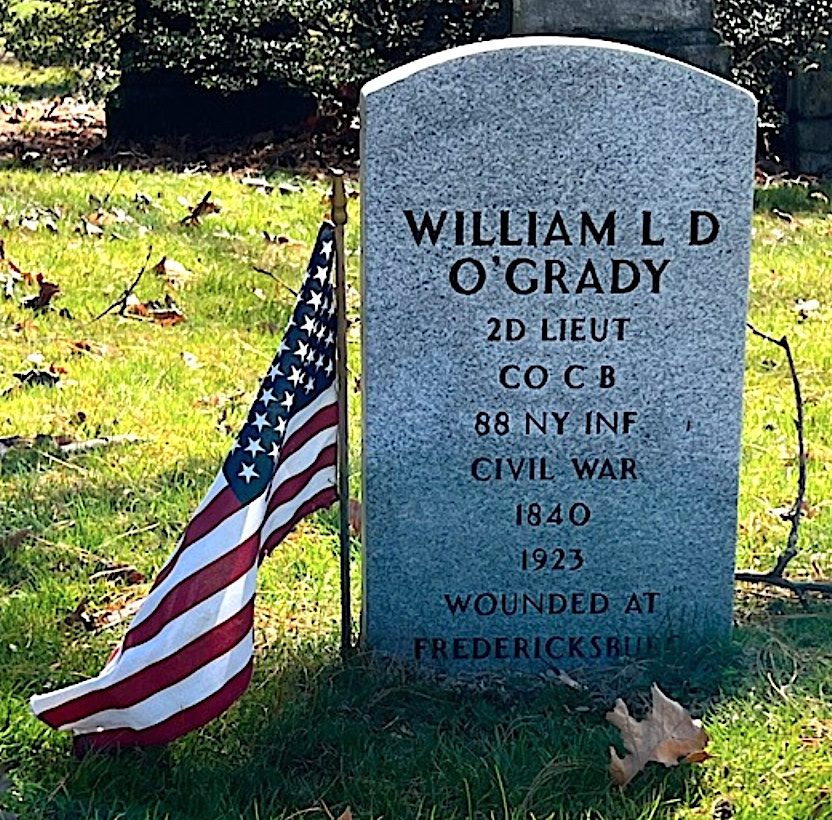
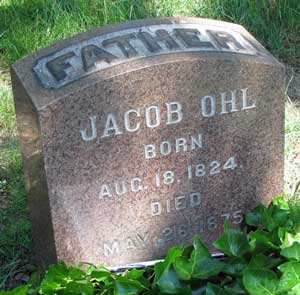
OHL, JACOB (1824-1875). Private, 176th New York Infantry, Company H. Originally from Germany, Ohl immigrated to the United States aboard the Oneida which departed from Le Havre, France, to New York on May 31, 1845. On October 11, 1852, Ohl became a naturalized citizen. The 1855 New York State census reports that Ohl lived in New York City with his wife and children; the children were baptized in Mount Vernon, New York in 1858. As per the census of 1860, the family lived in Eastchester, New York (Mount Vernon). His Draft Registration of July 1863 indicates that he lived on Mercer Street in New York City and was a baker.
Ohl enlisted on August 25, 1863, at New York City, the same date that he mustered into the 176th New York as a private. His muster roll notes that he was a substitute and that he was absent and sick at Annapolis, Maryland, on October 19, 1864. As per his muster roll, he was detached as a baker to Augusta, Georgia, as of June 16, 1865. He mustered out with his company on April 27, 1866, at Savannah, Georgia.
The census of 1870 and the New York City Directories for 1872, 1875 and 1876 state that Ohl was a baker. As per his death certificate, he was married and worked as a baker; his death was entered in the records of the New York Episcopal Diocese as a member of Shepherds Flock Chapel. His last residence was 412 West 49th Street in Manhattan. In 1880, Christina Ohl applied for and was granted a widow’s pension, certificate 695,123. Section 85, lot 5229, grave 26.
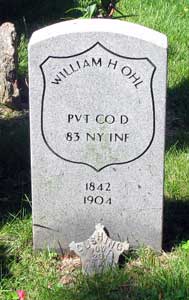
OHL, WILLIAM H. (1842-1904). Private, 83rd New York Infantry, Company D. Born in Philadelphia, Pennsylvania, Ohl was baptized there at the Trinity Episcopal Church on June 2, 1842, about two months after his birth. During the Civil War, he enlisted and mustered into the 83rd at New York City on May 27, 1861. Less than a month later, on June 23, he was discharged for disability at Washington, D.C.
According to New York’s Episcopal Diocese Church Records, Ohl married Leonora Bainbridge on September 28, 1865. In 1880, he applied for an invalid pension, application 396,189, but there is no evidence that it was certified. The 1880 census reports that Ohl and his wife and children were living in Fanwood Township, New Jersey, with William’s parents and siblings; both William and his father were in the shipping business. The 1895 New Jersey State census and the 1900 census indicate that Ohl was married and lived in Newark; the 1900 census and the 1903 Newark Directory report that he was an insurance agent. Ohl was a member of Cushing Post #231 of the G.A.R. As per his death certificate, he was married and in the insurance business. He last lived at 348 Grand Avenue in Brooklyn. His death was attributed to apoplexy. Section 186, lot 20076, grave 8.
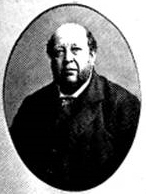
OKIE (or O’KIE), WILLIAM SANFORD (1835-1894). Private, 71st Regiment, New York State Militia, Company C. Born in New York City, Okie joined the American Guard, a name that was first used by the 71st Regiment, in 1854, primarily for social contacts according to his sketchbook page. His sketch emphasized his fun-loving nature, rollicking humor, and enjoyment in getting together with his comrades. He served for three months with the 71st in 1861 and fought at Bull Run, Virginia, at which time a ten-pounder nearly struck him in the head. On May 21, 1862, he married his first wife, Margaret Ridley, in the Dutch Reformed Church. Okie remained with the 71st until 1868 when he joined the Veterans Association of the regiment.
In civilian life, he established a commission business in New York City, helped organize the Mercantile Exchange, and belonged to the American Legion of Honor and other fraternal organizations. The 1870 census reports that he lived in Jersey City, New Jersey, and was a produce (corn) merchant; the 1876 New York City Directory lists him as a produce merchant with a home address in New Jersey. Active in his community, the New York Daily Tribune reported on March 31, 1877, that Okie was a Democratic candidate for the Board of Education in Jersey City. As per the 1880 census, Okie was a produce dealer living in Jersey City; his wife Margaret died on December 4, 1880. The Jersey City Directory for 1883 lists Okie as an egg merchant and the 1888 New York City Directory lists him as a merchant. According to the 1890 Veterans Census of Hudson County, New Jersey, his service in the 71st New York State Militia was confirmed and he was then living in Jersey City. The 1891 New York City Directory reports that he was in produce. As per his obituaries in the New York Herald and the New York Daily Tribune, he was a member of the Lafayette Post #140 of the G.A.R., and the Veterans Association of the 71st Regiment; members of those organizations and members of the New York Mercantile Exchange were invited to attend his funeral. His last residence was 29 High Street in Jersey City. He succumbed to a cerebral apoplexy. Maria E. Okie, his widow and second wife, who is interred with him, applied for a pension that was granted, certificate 668,250. Section 109, lot 10125, grave 6.
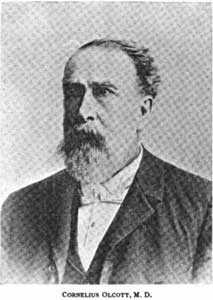
OLCOTT, CORNELIUS (1828-1897). Volunteer surgeon. Born in Jersey City, New Jersey, Olcott’s lineage can be traced back to the first settlers in Hartford, Connecticut. As per his obituary in the Brooklyn Daily Eagle, he was educated at academies in New Hope, Pennsylvania, and Lambertsville, New Jersey. He began his medical studies in 1843 in Jersey City but completed them at the University of New York in 1848, ultimately becoming a surgeon. In 1849, he settled in Brooklyn where he opened his medical practice. The 1860 census reports that his nephew, Eugene Sands Olcott (see), a medical student, lived with him. According to his obituary in The New York Times, Dr. Olcott served as a volunteer surgeon under General George B. McClellan at Fort Monroe, Virginia, and later served under General Ulysses S. Grant. The Brooklyn Daily Eagle notes that he also served under General Ambrose E. Burnside in the disastrous Fredericksburg Campaign.
After the War, he devoted himself to a general medical practice in Brooklyn and was also a patron of the arts, collecting fine paintings and sculptures. His obituaries noted that he is credited with being the first man in the country to successfully perform a Caesarean section in 1874; that surgery was acclaimed in medical journals at that time. He was among the founders of the summer community at Greenwood Lake Park, New York, and was the president of the Greenwood Lake Association. According to his obituary in the Brooklyn Medical Journal (Volume XI, December 1897), Olcott was a “moving spirit” in the development of the resort community at Greenwood Lake because of his energy, foresight and enterprise. A member of the Kings County Medical Society, the Physicians’ Mutual Aid Association, the American Institute of Christian Philosophy, he also belonged to the Brooklyn and Hanover Clubs.
The Brooklyn Medical Journal, in speaking of Olcott’s character, stated, “…Thus, appreciating the importance of intelligent, conscientious action, he regarded the exercise of his franchise as a citizen as a sacred duty and never failed to discharge it….” His colleagues admired him for believing that professional judgment and skill should be well compensated but, on the other hand, those in distress or poverty should be given time, skill and money, and as such, Olcott was considered a skillful Samaritan and a household word. In an article about his funeral in the Brooklyn Daily Eagle, it was noted that there were many beautiful floral tributes and an Episcopal service after a tribute to Olcott’s life. His obituary in the Brooklyn Daily Eagle notes that his son, Dr. Charles Olcott, his wife, and another physician were at his bedside when he died. His daughter, Lillian Olcott, who predeceased him, was a well-known actress. He last resided at 572 Bedford Avenue, Brooklyn. His death was caused by pneumonia, after suffering from the “grippe,” an old-fashioned term for the flu. Section 32, lot 12255.
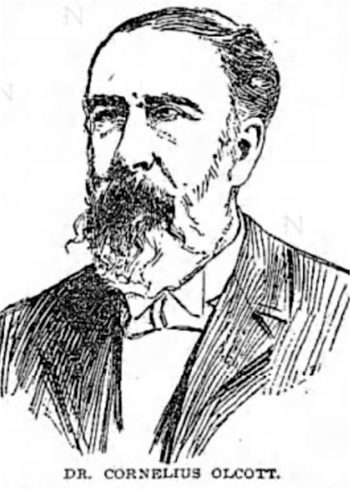
OLCOTT, EUGENE SANDS (1841-1864). Assistant surgeon, United States Navy. Olcott’s place of birth is unclear; one document says Brooklyn but the 1860 census says Kentucky. As per the 1860 census, Eugene was a student of medicine living with his uncle, Cornelius Olcott (see), in Williamsburg, Brooklyn. Olcott graduated from the University Medical College in 1862. He joined the United States Navy on January 24, 1862, was commissioned as an assistant surgeon, and appointed by President Abraham Lincoln (see below), on April 1, and served on the steam gunboat Cimarron. The Cimarron was launched from Bordentown, New Jersey, on March 16, 1862, and saw service in the James River Campaign. On January 21, 1863, he married Adelaide Johnson in Brooklyn. According to his widow’s pension application, he was debilitated by malaria while on duty in the James River in the summer of 1862. Subsequently, he suffered from pulmonary hemorrhages and then acute tuberculosis which necessitated his resignation. He resigned his commission, and his resignation was accepted by Gideon Welles, Secretary of the Navy, on January 6, 1864, at which time he was honorably discharged.
After Olcott’s death from tuberculosis (that he contracted while in service) on September 29, 1864, he was originally interred at Cypress Hills Cemetery. Olcott was re-interred at Green-Wood on June 28, 1865. As of May 17, 1875, Adelaide Olcott received a widow’s pension of $20.00 per month, certificate 2,092. Cornelius Olcott, his uncle, attested in Adelaide Olcott’s pension application that Eugene contracted tuberculosis from exposure during his Naval service, that he tended to him in Brooklyn prior to his death, and that he was fully aware of Eugene’s health before and after his service. Section 159, lot 15896.


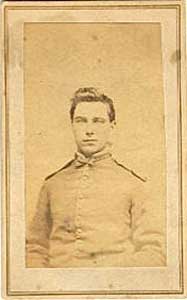
OLDS, EDWARD ALLEN (1844-1926). Private, 17th Independent Battery, New York Light Artillery. Olds, a native of Lockport, New York, and a store clerk there, enlisted at Medina, New York, as a private, on August 18, 1862. On August 26, he mustered into the 17th Independent Battery, and was discharged on June 12, 1865, at Richmond, Virginia. In 1872, he was a partner in Packer’s Tar Soap Co. in Mystic, Connecticut, but later relocated to Brooklyn. The Veterans Schedule of 1890 confirms his military status. His last residence was at the Marie Antoinette Hotel in New York City. He died from pneumonia. Section 155, lot 23718, grave 2.
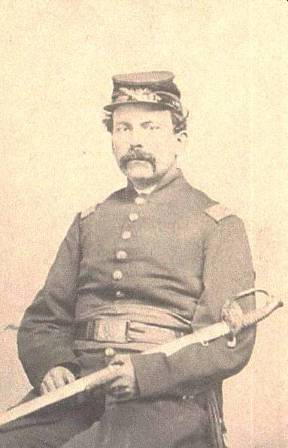
OLEY, CHARLES HUNT (1827-1892). Captain, 112th New York Infantry, Company I. Born in Utica, New York, Oley lived in Manhattan and worked as a merchant according to the 1855 New York State census reports. He enlisted as a captain on August 28, 1862, at Pomfret, New York, and was commissioned into Company I of the 112th New York on September 2, 1862. According to the Statistical History of the 112th New York Volunteers, Oley, a resident of New York City, was traveling in the area of Pomfret when a local man withdrew as captain of Company I. Oley, who had some experience in the State Militia, was recommended by the County Military Committee and was selected as that company’s captain. The aforementioned document reports that he worked hard with his men to promote discipline and efficiency and was frequently detailed to engineering duty in Suffolk, Virginia. As per his muster roll, Oley was a merchant who was 5′ 7½” tall with dark brown eyes, dark brown hair and a dark complexion. His muster roll notes that he was absent and sick on July 3, 1863, and returned to the rolls the next month. Oley was detailed on court martial on March 2, 1864, and returned on March 18. He was listed as absent and sick as of July 8, 1864, at Petersburg, Virginia, was hospitalized at Hampton, Virginia, and received a disability discharge there on November 28, 1864.
The 1865 New York State census reports that he lived in Brooklyn and was a clerk. The records from the Episcopal Diocese of New York note that he married Jennie Briggs Hedges, his second wife, on August 29, 1871, in Brooklyn. On May 2, 1876, he received a patent for a scroll-sewing machine (below). A man who had many occupations, both the 1875 New York State census and the 1875 Brooklyn Directory list him as a manager; the 1880 census states that he lived in Brooklyn and was a furrier. The 1884 Brooklyn Directory reports that he was a broker. His death certificate indicates that he was married and was a chemist. His last residence was at 514 Pacific Street in Brooklyn. His death was attributed to lung problems. Shortly after his death in 1892, Jennie Oley, who is interred with him, applied for and received a widow’s pension, certificate 394,220. Section 155, lot 23298.
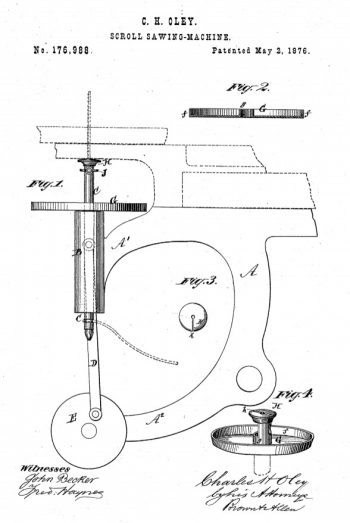
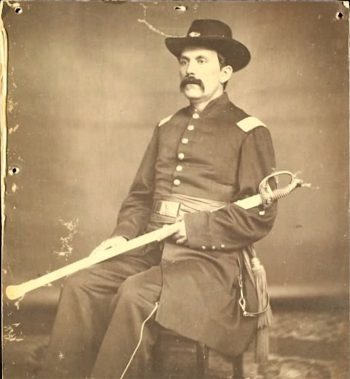
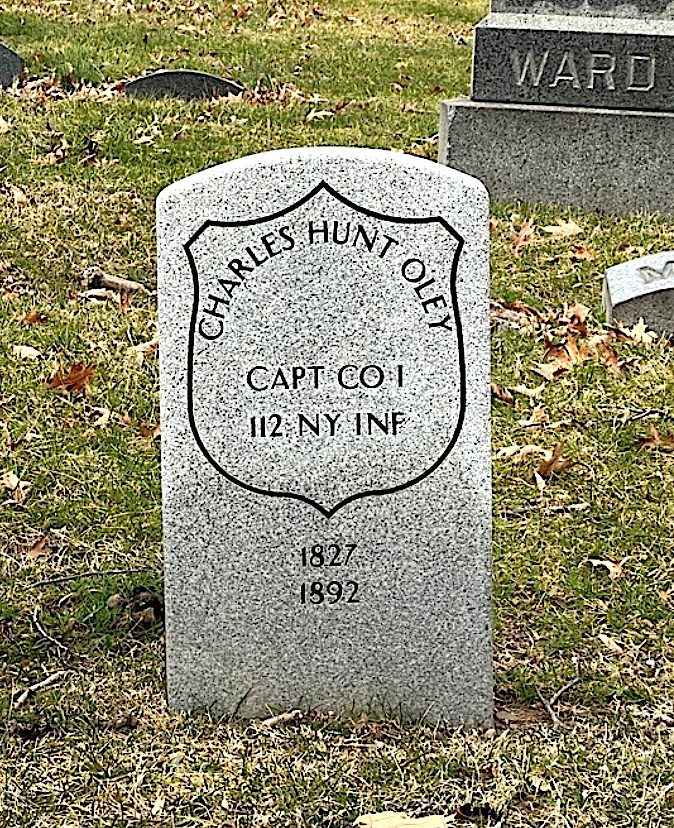
OLIVER, HENRY (or HARRY) R. (1842-1891). First lieutenant, 28th Regiment, New York State National Guard, Company F. Oliver and his parents immigrated to the United States from London, England, on the Wellington, arriving in New York City on September 11, 1843; on the passenger manifest, Henry is listed as a one-year-old. As per the New York State census of 1855 and the census of 1860, Oliver and his parents were born in London and his sister was born in Ohio. At the time of those censuses, the family lived in Brooklyn; the 1860 census reports that Oliver’s mother had died and that both he and his father were working as paperhangers. During the Civil War, Oliver enlisted on August 10, 1864, at Brooklyn, was commissioned into the 28th Regiment as a first lieutenant and mustered out after 100 days on November 13 at New York City. He also served in Company B of the 13th Regiment as per his pension index card.
The 1865 New York State census reports that Oliver was married to Emma and the couple was living in Brooklyn with his father and step-mother; Henry Oliver was working as a clerk. As per the 1875 New York State census, the couple lived in Brooklyn with his wife’s sister and other family members; he was listed as “Harry” and was working as a “traveling agent.” According to the 1880 census, Oliver and his wife and children lived at 162 Clifton Place in Brooklyn; he was listed as a “druggist agent.” The Brooklyn Directories for 1882 and 1889 indicate that Oliver lived at the same Clifton Place address; the 1882 publication shows that he was a salesman. The 1890 Veterans Schedule, which lists him as Harry Oliver, confirms his Civil War service. In 1890, his application for an invalid pension was granted under certificate 682,804.
Oliver also worked in Columbia, South Carolina; the Columbia City Directory for 1891 indicates that he was a salesman at 160½ North Richardson. As per his obituary in the Brooklyn Daily Eagle, he was a member of the De Witt Clinton Council of the Royal Arcanum; members of that organization were invited to attend his funeral at his Brooklyn home. He died in Columbia, South Carolina, where his father died in 1890. His last address was 162 Clifton Place in Brooklyn. His funeral took place at the home of his son-in-law, Fred J. Brown, at 12 Charles Street in New York City. Emma Oliver, who is interred with him, applied for and received a widow’s pension in 1891, certificate 377,994. On November 21, 1897, the Brooklyn Daily Eagle reported that Minnie Josephine Oliver, Henry and Emma’s daughter, got married at the Clifton Place home of her mother and step-father. Minnie’s brother, Harry C. Oliver, was an usher; the newly married couple planned to tour the South on their honeymoon. Section 167, lot 16954.
OLIVER, JAMES A. (1848-1928). Private, 39th New Jersey Infantry, Company I. As per the censuses of 1880 and 1900, Oliver was born in Kent, England; the 1900 census reports that he immigrated to the United States in 1852. The census of 1860 indicates that the Olivers were living in Chatham, New Jersey; Ireland is given as his birthplace. After enlisting as a private on August 9, 1864, Oliver mustered into the 39th New Jersey Infantry on October 1, and mustered out on June 17, 1865, at Alexandria, Virginia. His obituary in the Brooklyn Daily Eagle, which incorrectly states that he was born in Madison, New Jersey, notes that he participated in the major campaigns of the Northern Army and that he was affectionately referred to as “Colonel Oliver” by his neighbors, although he served in the ranks. That obituary also states that James Oliver’s father, William Oliver, was killed at the Battle of Bull Run, Virginia.
The 1870 census, which also lists Oliver’s birthplace as Ireland, notes that he lived with his mother and siblings in Chatham, New Jersey, and worked with a painter. The 1880 census reports that he was living with his wife and children on 175th Street in Manhattan and was working as a painter. The census of 1900 reports that he was living on 3rd Street in the Bronx with his wife and children and still employed as a house painter. In 1909, his application for a pension was granted, certificate 1,051,233. The 1910 census shows that he relocated to 515 Locust Avenue in Rye, New York, and was a house painter. At the time of the 1915 New York State census, Oliver had retired and lived with his daughter and son-in-law in Brooklyn. His obituary also indicates that Oliver was active in the Grand Army of the Republic. Oliver’s death certificate, which incorrectly states that he was born in the United States, notes that he was married and worked as a painter; he was also survived by four daughters and two sons. He died instantly after falling down the steps leading to the cellar in his home. As per his obituary in The New York Times, his funeral took place at the home of his daughter at 482 East 8th Street in Brooklyn. In 1928, Helen Treadwell Oliver, applied for and received a widow’s pension, certificate a-3-8-29. Section C, lot 35956, grave 3.

OLIVER, PAUL AMBROSE (1831-1912). Medal of Honor recipient; brigadier general by brevet; captain, 5th New York Veterans Infantry, Companies D and E; first lieutenant and acting aide-de-camp, 12th New York Infantry, Company E. Born at sea aboard an American flagship, the Louisiana, in the English Channel, he was a shipping merchant before the Civil War in New York City and New Orleans. In 1856, he organized the Fort Hamilton Relief Society in Brooklyn to prevent the spread of yellow fever there.
After enlisting as a second lieutenant at New York City on October 29, 1861, Oliver was commissioned into Company E of the 12th New York. He was promoted to first lieutenant on May 17, 1862, and was an acting aide-de-camp on the staffs of Major Generals Daniel Butterfield, George C. Meade, Joseph Hooker, and Gouverneur K. Warren. On June 27, 1862, he was wounded in the head by a musket ball at Gaines’ Mills, Virginia. Brigadier General Daniel Butterfield, his commanding officer, praised him for his conduct in his field report from Harrison’s Landing, Virginia, on July 11, 1862. Oliver commanded his company in Virginia at Second Bull Run, at Antietam, Maryland, and at Fredericksburg, Virginia, before being detached from the 12th and appointed as an aide to Major General Butterfield on December 16, 1862. Subsequently, he was on the staff of General George Meade beginning in June 1863 and then in October on the staff of General Joseph Hooker who cited him for gallantry on November 6, 1863, from Lookout Valley, Tennessee. Upon his promotion to captain on January 1, 1864, he transferred into Company E of the 5th New York Veterans, and was immediately reassigned to Company D. Hooker once again singled out Oliver for congratulatory remarks in his report from Lookout Valley on February 4, 1864, noting his bravery and intelligence.
A recipient of the Medal of Honor, Oliver was recognized for his actions as an aide on May 15, 1864, at Resaca, Georgia, that prevented a disaster when Union troops fired into each other. In July of that year, he was detached to the staff of Gouverneur K. Warren with whom he served until January 1865. On March 8, 1865, he was brevetted to brigadier general by General Grant. Brevet Brigadier General George S. Sharpe, on April 20, 1865, cited his service as “invaluable and highly meritorious…” Oliver was ordered to the headquarters of the Union Army by General Ulysses S. Grant, and sent to Appomattox, where he took part in the paroling of the Confederate Army of Northern Virginia. He resigned on May 6, 1865.
From 1865-1869, Oliver was in the coal business in Elizabeth, New Jersey. Relocating to Wilkes-Barre, Pennsylvania, he then became a powder manufacturer and inventor designing machinery that could manufacture gunpowder in small quantities to reduce the risk of explosion. In 1903, he sold the company to DuPont. The following year, he was awarded a pension for his military service. He last lived in Laurel Run, Luzerne County, Pennsylvania, where he died of a brain concussion after a fall. Section 78, lot 3212.
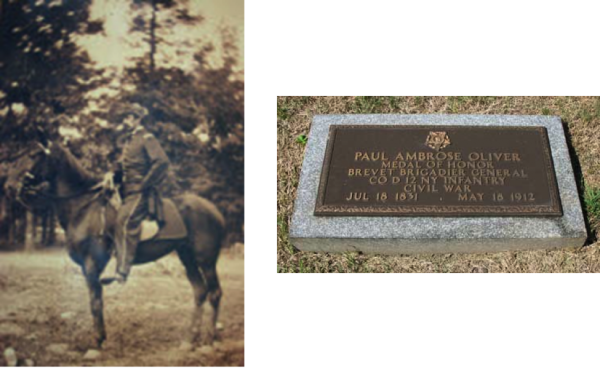
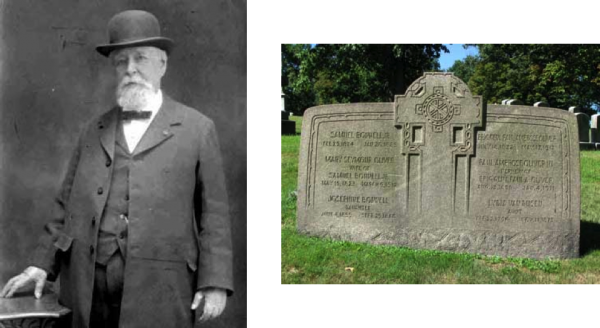
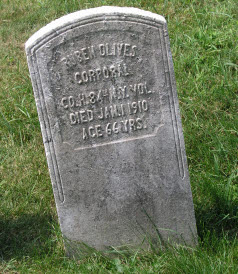
OLIVER, REUBEN FLETCHER (1845-1910). Corporal, 84th Regiment, New York State National Guard, Company H; private, 5th New York Heavy Artillery, Company F. Oliver was born in Newark, New Jersey. The 1850 census reports that he lived there with his parents and siblings; his father was a shoemaker. At the time of the 1860 census, he lived in New York City. During the Civil War, Oliver enlisted as a private at New York City on July 22, 1862, and mustered into Company F of the 5th New York Heavy Artillery the next day. His muster roll notes that he was a trunk-maker who was 5′ 7½” tall with brown eyes, light brown hair and a fair complexion. On September 15, 1862, he was taken as a prisoner of war and released the same day at Harpers Ferry, Virginia (now West Virginia). His soldier record notes that he deserted at Fort Marshall in Baltimore, Maryland, on March 1, 1863. Subsequently, Oliver re-enlisted and served for 30 days in 1863 when the 84th Regiment was activated in New York State.
On November 1, 1868, Oliver married Sarah Wilson at the City Mission Society in Manhattan; his marriage record notes that he lived at 89 Perry Street in Manhattan and was an engineer. The 1870 and 1880 censuses noted that he was married with children, lived in Manhattan, and worked as an engineer. Sarah Oliver died in Brooklyn on August 29, 1888, and is interred with him. The 1889 and 1890 Brooklyn Directories list him as an engineer with an address at 24 16th Street. The Veterans Census of 1890 confirms Oliver’s Civil War service. As per the 1900 census, he lived on 18th Street in Brooklyn with his children and was still working as an engineer. At the time of his death in Brooklyn, he was a widower who was an engineer. His government-issued gravestone, about 100 years old, misspells his name as “Ruben Olives.” Section 6, lot 20118, grave 631.
OLNEY, GEORGE W. (1834-1916). War correspondent, Confederate States of America. Originally from Charleston, South Carolina, he was descended from men who fought in the American Revolution in Rhode Island. After graduating from Harvard with a law degree in 1855, he embarked on a career in journalism as publisher of the Daily Day Book. During the Civil War, he returned to the South where he first worked on the staff of the Richmond Enquirer, then was a war correspondent and subsequently served as editor of the Charleston Courier. As per his obituary in The New York Times, he described the first shots of the Civil War.
In 1866, Olney became a drama writer for New York Herald, then was editorial writer for the New York World from 1868 to 1876. He subsequently became an insurance writer for the New York Underwriter, later renamed the Weekly Underwriter and served as editor and vice president of the Underwriter Printing and Publishing Company. The author of several statistical works, he was a member of the American Statistical Association and the Royal Statistical Society of Great Britain. He was editor of the World Almanac as of 1870 and the Insurance Almanac and Record of Fire Insurance by State. Active in military and patriotic organizations, he was a member of the Sons of the American Revolution, Society of Colonial Wars, Society of War of 1812, Veteran Corps of Artillery of New York, and former secretary of the Society of the Cincinnati in Rhode Island. The censuses of 1900 and 1910 list him as a newspaper editor. His name is inscribed on the Correspondents’ Arch at Crampton’s Gap, Maryland, a monument erected by George Alfred Townsend in 1896 to memorialize those who had covered the Civil War in print, photograph or illustration. He last lived at 461 West 158th Street in New York City. His death was caused by bronchitis. Section 187, lot 20028.
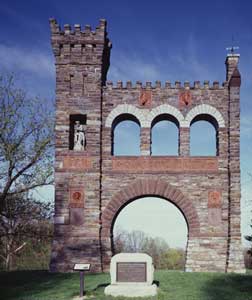
OLSSEN, WILLIAM EDWARD (1834-1867). Private, 6th New York Cavalry, Company K; 2nd New York Provisional Cavalry, Company K. Olssen was born in New York. The 1850 census reports that he lived in New York City and that his father and older brothers were trunk-makers. The New York Herald announced his marriage to Susan Rese on January 12, 1856. According to the 1860 census, he was living with his in-laws in Manhattanville, New York, worked as a manufacturer and had a personal estate worth $200. The Episcopal Church Records of the New York Diocese indicate that he was baptized on March 30, 1861. His older brother, James Olssen of the 1st New York, was killed at the Battle of Malvern Hill, Virginia, on July 1, 1862. His Draft Registration of July 1863 notes that he was a carriage-maker.
William Olssen enlisted at New York City as a private on December 17, 1863, and mustered into Company K of the 6th New York Cavalry on that date. As per his muster roll, he was a conductor by occupation and was 5′ 3″ tall with blue eyes, dark hair and a fair complexion. He was listed as absent at Dismount Camp on October 31, 1864. On June 17, 1865, he transferred into the 2nd Provisional Cavalry when the 6th was consolidated into that regiment. He mustered out the next day at Philadelphia, Pennsylvania, as per a directive of the War Department. His funeral was held at the home of his brother-in-law, John B. Edwards (see), with whom he lived at 116 Mercer Street in Jersey City, New Jersey. He succumbed to consumption. Section 101, lot 4436.
ONDERDONK, JOHN WESLEY (1843-1862). First sergeant, 38th New York Infantry, Company D. Onderdonk is not buried at Green-Wood; a cenotaph honoring his memory and his Civil War service is at Green-Wood. He was born in Rockland, New York. As per the census of 1850, he was living in New York City with his aunt, Abigail Onderdonk Myers and her husband, Bernard Myers, a baker and lifelong abolitionist; the Myer children also lived in the household. The 1855 New York State census reports that John and his sister, Frances, lived with the Myers’s family in New York City; at the time of the 1860 census, the Myers’s had moved to Brooklyn and John was an apprentice baker to his uncle. After enlisting as a private at New York City on September 21, 1861, Onderdonk mustered into Company D of the 38th New York two days later. He was promoted to sergeant on October 17, 1862, and to first sergeant on or about November 15, 1862. He died at the Battle of Fredericksburg, Virginia, on December 13, 1862. His cenotaph reads:
IN MEMORIAM
JOHN WESLEY ONDERDONK
1ST SERGT
- D. 38TH N. Y. VOL.
FELL AT
FREDERICKSBURG, VA.
DEC. 13TH 1862,
IN HIS 19TH YEAR.
INTERRED AMONG THE
UNKNOWN ON THE
BATTLEFIELD.
His cenotaph is in the same lot as the remains of his aunt and uncle, Abigail O. and Bernard Myers (see photo below). Bernard Myers’s headstone inscription reads, “A father to the fatherless. His life was a benediction.” Abigail Onderdonk Myers’s inscription reads, “Gentle mother. She scattered love as stars do light.” Section 186, lot 29608.
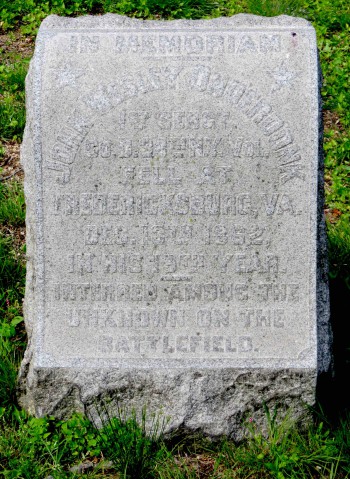
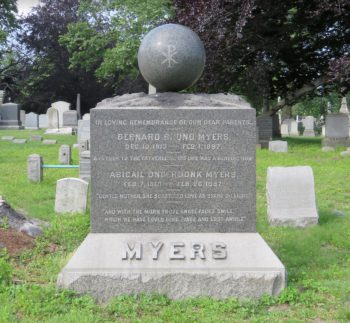
O’NEIL (or O’NEILL), CHARLES FEATHERSTON (1827-1896). Acting master’s mate, United States Navy. Originally from Dublin, Ireland, O’Neil began his service in the United States Navy when he enlisted as a mate at Philadelphia, Pennsylvania, on November 2, 1852 (although one pension document says November 1850), and re-enlisted several times; his last was on October 20, 1862. He married Jane Flynn on July 27, 1862, at St. Peter’s Episcopal Church in New York City. Prior to the Civil War, O’Neil began service as captain of the forecastle on the USS Mohican (as of 1859) and was transferred to the USS Passaic as a quartermaster in September 1862, where he remained until May 26, 1863, when he was appointed acting master’s mate. The USS Passaic, an ironclad, was built in Greenpoint, Brooklyn, under the direction of John Ericsson, the famed mechanical engineer who designed the USS Monitor. O’Neil then was transferred to the USS Sumter and subsequently served on the USS Brandywine, USS Delaware, USS Valley City, USS North Carolina, USS Rhode Island and USS Augusta. Although one record states that he deserted on June 15, 1865, that is incorrect: Navy records show that he was granted a leave of absence of two weeks on that date. O’Neil was discharged on June 13, 1867, at the Washington Navy Yard in Washington, D.C.
The New York City Directory for 1880 lists O’Neil as a janitor. On February 2, 1886, he became a member of the John A. Dix Post #135 of Grand Army of the Republic; he listed his occupation as sexton, a person who looks after a church and its churchyard, in the post’s sketchbook. The 1889 New York City Directory lists O’Neil as a sexton. As per an article in the Weekly Press on August 27, 1890, O’Neil was one of six seamen who accompanied the glass-covered hearse of John Ericsson when his remains were removed from Marble Cemetery for re-interment in his native Sweden. O’Neil received a pension from the Navy beginning in 1895, certificate 35,794. At the time he filed for a pension, he was 5′ 5½” tall with tattoos of a lady resting on an anchor ship and a crucifix of Jesus in India ink. It was noted in his widow’s pension application that Charles O’Neil suffered from rheumatism, eye problems, and dizziness as of 1894, making it impossible for him to perform manual labor. As per his obituary in The New York Herald, he was a Freemason; members of his lodge and members of the John A. Dix Post were invited to attend his funeral. His funeral took place at St. Augustine’s Chapel, Trinity Parish, where he had been a sexton and clerk at the chapel for 19 years. Colorado and Dublin, Ireland, papers were asked to print his obituary. His last residence was 105 East Houston Street in Manhattan, next door to the church. Jane O’Neil, who is interred with him, applied for and received a widow’s pension of $8.00 per month as of March 10, 1876, certificate 15,957. Section 196, lot 27653, grave 1.
OPDYKE, WILLIAM NEELY (1829-1880). Private, 139th New York Infantry, Company G. Born in New York State, he enlisted as a private at Brooklyn on August 25, 1862, and mustered into the 139th on September 9. He served at Fortress Monroe in Hampton, Virginia. Though service records list him as a deserter on January 11, 1863, at Fort Monroe, that appears to be incorrect; his widow, Annie Opdyke, in 1890, applied for and received a widow’s pension, certificate 353,178. At the time of the 1870 census, he was married, lived in Brooklyn and worked as a locksmith. The 1880 Brooklyn Directory lists him as a locksmith. As per his death certificate, he was married and worked as a locksmith. His brother-in-law, John Macpherson (see), is buried near him. His last residence was 99 Elm Street in Brooklyn. He died of erysipelas, a bacterial infection of the skin. Section 114, lot 8999, grave 1132.
OPPERMAN, HENRY (1846-1925). Private, 30th New York Light Artillery; 31st New York Light Artillery. Opperman was born in Hildesheim in Hanover, Germany. As per an article about his 70th birthday in the Brooklyn Daily Eagle on October 1, 1916, he belonged to a volunteer group of 300 men during the troubles in Schleswig-Holstein, a conflict between Denmark and the German nationalists over the rule of those duchies. Opperman’s group disbanded after the Prussians arrived and he and the others fled to the United States and landed in Portland, Maine, in March 1864. Although some of the 300 refuges enlisted in Maine regiments during the Civil War, about 50, like Opperman, came to New York where they joined the Union cause. Opperman enlisted at Brooklyn on April 4, 1864, as a private, and mustered immediately into the 30th New York Light Artillery. He was transferred into the 31st Light Artillery on October 25, 1864, and mustered out on June 23, 1865, at New York City.. As per his obituary in the Daily Review [Long Island], which confirms his Civil War service, Opperman was purportedly a member of a posse in search of John Wilkes Booth after he assassinated President Abraham Lincoln on April 14, 1865; Booth was found and shot by a Union soldier 12 days later while hiding in a barn near Fredericksburg, Virginia (Booth’s companion gave himself up).
Opperman re-enlisted in the Regular Army in 1866 and was assigned to the 7th United States Cavalry, Company C, Lieutenant Colonel George Armstrong Custer’s regiment. After the Civil War, the U.S. Army shrank back down–and officers had their ranks adjusted. So Custer, who had been a general during the Civil War, was no longer one–he was the lieutenant colonel of the 7th. The Daily Review reports that Opperman was with Custer in over 40 battles with the Plains Indians including the Sioux, Apaches, Kiowas, Comanches, Cheyennes and Arapahoes. The campaign began in Colorado in 1867 and ended in Indian Territory with the Battle of the Washita in 1868. In the latter battle, near present day Cheyenne, Oklahoma, Custer and the 7th Cavalry surrounded the Indian village of Cheyenne Chief Black Kettle of the Cheyenne; Black Kettle and 103 Indian fighters were killed, the village of 600 tepees along the Washita River was destroyed, women and children were captured and all provisions—buffalo hides, arrows, tobacco, dried meat, rifles, lariats, etc. were confiscated. Opperman remained with Custer until August 9, 1871. He re-enlisted in the Regular Army in 1874, and was assigned to recruiting stations in St. Louis, Missouri, and New York. His muster roll for that enlistment indicates that he described himself as a clerk who was 5′ 8½” tall with hazel eyes, light hair and a fair complexion. It was during this service that he became acquainted with people who worked for the railroads and after his discharge in 1879, worked first for the Erie Railroad as an advertising agent, rose to passenger agent, and then, in 1887, took that position with the Pennsylvania Railroad.
A larger than life personality, the Daily Review noted that Opperman counted among his friends Buffalo Bill, William F. Cody and Wild Bill Hickok (a scout for the 7th Cavalry). The 1885 and 1888 Brooklyn Directories list him as a passenger agent. The 1890 Veterans Census, which confirms his Civil War service, indicates that he then lived at 162 President Street in Brooklyn. The 1892 New York State census shows that he lived at 158 President Street with his children and worked as an agent. As per the 1900 census, he lived in Brooklyn with his second wife, Elizabeth, and his children, was a naturalized citizen and worked as an agent for the Pennsylvania Railroad, the company that employed him for twenty-six years. In 1908, he applied for and was granted a soldier pension, certificate 1,150,591. The 1910 census indicates that he lived in Hempstead, New York, had been married for 17 years and was an agent for a steamship line. He retired from the Pennsylvania Railroad because of failing health in April 1914, was placed on the company’s honor roll and pensioned. On May 8, 1922, the Daily Review reported that Opperman was appointed aide-de-camp to Louis Steven Pilcher, the commander-in-chief of the Grand Army of the Republic (G.A.R.); that article hailed him as an “old Indian fighter.” The Daily Review, in an article on July 3, 1923, noted that Opperman, the old warrior, once again escaped death after recovering from surgery at the Rockville Centre Sanitarium.
According to his obituary in the Brooklyn Daily Eagle, he was a Freemason (as of 1872) and member of the Ulysses S. Grant Post #327 of the G.A.R.; members of both fraternal groups were invited to the services which included a Grand Army ritual. As per his obituaries in The New York Times and the Brooklyn Daily Eagle, and his local newspaper, the Daily Review, his funeral was held at the U. S. Grant Post Hall at 489 Washington Avenue in Brooklyn; the pastor of the Baldwin Methodist Church officiated at the services. He last lived at 46 South Grand Avenue in Baldwin, Long Island. His death was attributed to apoplexy. The Daily Review reported on January 27, 1925, that Opperman left his widow $1,000 and the income derived from the sale of his Grand Avenue property; other personal items were left to his children and grandchildren. According to another article about his death in the Daily Review on March 12, 1925, which extended condolences to his widow and family, Opperman was a charter member and on the Board of Governors of the Baldwin Country Club; he was lauded as “an inspiration, capable, dutiful and upright.” Elizabeth J. Opperman applied for and received a widow’s pension in 1925, certificate 959,986. Section 192, lot 24718.
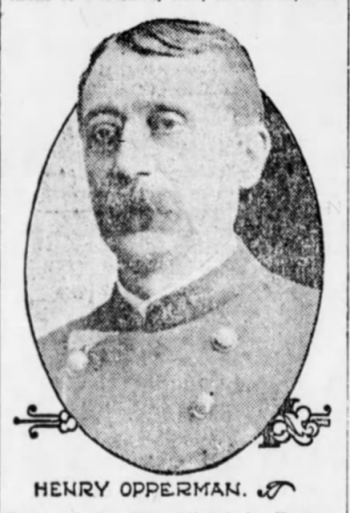
ORAM, STEPHEN (1829-1876). Private, 8th Regiment, New York State Militia, Company I. Oram served for three months with the 8th Regiment when it was activated in 1861. He died from burns at the Brooklyn Theater fire on December 5, 1876, a conflagration in which 150 people lost their lives. His last address was 66 Prince Street in Brooklyn. Section 109, lot 3950.
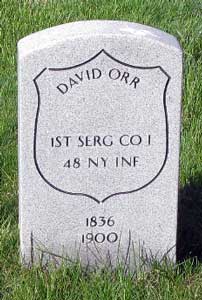
ORR, DAVID (1836-1900). First sergeant, 48th New York Infantry, Company I. Born in Ireland, Orr enlisted at Brooklyn as a first sergeant on July 20, 1861, and mustered into the 48th on August 16. He was reduced to private at some point and was later promoted to sergeant on June 19, 1863. On June 8, 1864, he was wounded at Cold Harbor, Virginia, and was discharged at the expiration of his enlistment. The 1865 New York State census, which indicates that he lived in Brooklyn with his wife and children, and the Brooklyn Directory for 1867, list him as a machinist. He is also listed as a machinist living on Sackett Street in Brooklyn on the 1875 New York State census, the 1878 and 1883 Brooklyn Directories and on the 1880 census, at which time he lived on Jay Street. He was granted an invalid pension in 1890, certificate 681,132. The 1892 New York State census reports that he lived with his wife and children in Brooklyn and was still employed as a machinist. Orr last lived in Brooklyn where he died from pneumonia.
After he died on January 31, 1900, he was buried in Evergreen Cemetery. His remains were removed and re-interred at Green-Wood on July 17, 1900. Eliza Orr applied for and received a widow’s pension in 1900, certificate 493,665. Ida Orr, who was identified as “a helpless child” on his pension index card and who is interred with him, was granted minor’s pension because of her disability in 1916, certificate 804,066; disabled children were entitled to pensions as per The Disability Act of June 27, 1890.. Section 205, lot 30588, grave 2.
ORSER, ALEXANDER S. (or L.) (1839-1866). Corporal, 22nd New Jersey Infantry, Company I. Orser was born in New York. The 1850 census reports that he lived in Manhattan with his parents and two siblings. At the time of the 1860 census, he lived with his parents and siblings in Hackensack, New Jersey; his father was a farmer whose real estate was valued at $17,000 ($487,000 in 2018 money) and Alexander Orser was working as an agent. During the Civil War, he enlisted as a corporal on September 1, 1862, mustered into the 22nd New Jersey on September 22, and mustered out at Trenton, New Jersey, on June 25, 1863. His regiment, consisting of volunteers from Bergen County, was first sent to Washington, D.C., then sent to Acquia Creek, Virginia, from the end of November to December 5, 1862, a march endured under arduous conditions. In January 1863, the 22nd joined the Third Brigade and proceeded to Belle Plain, Chancellorsville (where it was slightly engaged in battle), and then to Centreville before departing by train to Trenton. As per his 1863 Draft Registration Card, filed in Hackensack, New Jersey, he was a farmer. As per his death certificate, Orser was single, a farmer, and died in Teaneck, New Jersey. His death was attributed to “bilious intermittent fever.” Section 59, lot 1529.
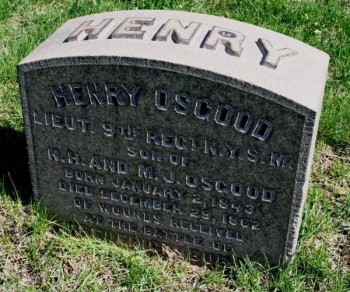
OSGOOD, HENRY (1843-1862). First lieutenant, 83rd New York Infantry, Company D. Osgood was born in Massachusetts. As per the census of 1860, he was living in New York City and working as a clerk. After enlisting as a private at New York City on May 27, 1861, he mustered into the 83rd (formed from the 9th Militia) the same day. He rose through the ranks to corporal, then to sergeant on November 4, 1861, to first sergeant on about June 15, 1862, and to first lieutenant (not mustered) on December 13, 1862, the same day that he was wounded in the abdomen at the Battle of Fredericksburg, Virginia. Osgood was hospitalized on December 23 at Lincoln Hospital in Washington, D.C., where he succumbed on December 29; other records give the date of his death as December 28 or December 30. Osgood’s name was listed on the Bodies in Transit List on January 4, 1863. He was removed from the muster rolls on January 15, 1863; his muster roll incorrectly reports that date as his date of death. He was interred at Green-Wood on January 5, 1863. Section 124, lot 14098.
OSLER, GEORGE W. (1827-1899). Private, 8th Regiment, New York State Militia, Company F. Osler was born in Harrisburg, Pennsylvania. His name was listed as a pipemaker in partnership with David A. Carnes in New York City in 1855 in the OHS Pipe Organ Database from A Guide to North America Organ Builders by David H. Fox; no specific organs are attributed to him. After enlisting on April 23, 1861, Osler served with the 8th Regiment for three months before mustering out on August 2.
As per records of the Dutch Reformed Church, Osler married Emma Rusher, who is interred with him, on January 14, 1864, at the Washington Square Church in Manhattan. When he applied for a passport on April 19, 1870, he described himself as 5′ 10″ tall with brown eyes, black hair, a high forehead, prominent nose, florid complexion, round chin, and long, oval face. After traveling to England, he left Liverpool on the Marathon and arrived in New York City on May 16, 1870. The 1881 census of Ontario, Canada, reports that Osler, a Lutheran, was living in Toronto with his wife and widowed sister, Abigail Fackler, and was working as an organ builder; a John Fackler, most likely Abigail’s son, was an organ builder in New York City. The 1891 Canadian census reports that Osler was living in St. Paul’s Ward with his sister and brother; all three were widowed. At that time, George Osler was still working as an organ builder. Osler’s death certificate, filed in Oxford, Canada, notes that he was a Baptist and suffered from heart disease. His death in Woodstock, Canada, a town that had an organ factory during the time Osler lived there, and his veteran status are inscribed on his tombstone. His widow, his second wife, applied for a pension in 1909, application 933,458, but there is no evidence that it was certified. Section 202, lot 27952, grave 4.

OSTERSTOCK (or OSTROCK), THEODORE (1834-1876). Private, 61st New York Infantry, Companies G and B. Osterstock was baptized at St. John’s Lutheran Church in Easton, Pennsylvania, on April 3, 1837, when he was about fourteen months old. The 1850 census reports that he still lived in Easton (Bushkill Ward) with his parents and siblings. As per articles in The New York Times on August 8, 9, and August 14, 1863, and the New York Herald on August 12, 1863, Osterstock, a circus rider, was convicted after trial of participating in a riot and breaking into Mr. Roesner’s Greenwich Street boot and shoe store on the second day of the New York City Draft Riots in July 1863. His sentencing was postponed to review testimonials to his good character; he was then sentenced on August 12 to three months in prison based on an acknowledgement by the judge of uncertain identification testimony of a witness and evidence of his good character. Although Osterstock claimed to be a circus rider, he was a proprietor of a lager beer saloon on Greenwich Street at the time of his conviction. His Draft Registration Form, filed in New York in July 1864, lists him as a soldier.
Osterstock enlisted as a private at Brooklyn on February 4, 1864, mustered immediately into Company G of the 61st New York, and was transferred intra-regimentally to Company G on December 21, 1864. His muster roll, which lists him as Theodore Ostrock, notes that he was absent and hospitalized at Washington, D. C., in April 1865. He mustered out on June 13, 1865, from White Hall General Hospital at Philadelphia, Pennsylvania. The New York City Directories for 1868 and 1869 list him as a barber. As per the census of 1870, he lived in Manhattan with his wife and was a barber; the New York City Directories for 1872 and 1873 continue to list him as a barber. He last lived at 10 Roosevelt Street, New York City. He succumbed to phthisis. Wilhelmenia (Wilhelmine) Osterstock, who is interred with him, applied for and received a widow’s pension in 1892, certificate 344,748. Section 15, lot 17263, grave 2081.

OSTRANDER, HANFORD L. (1842-1920). Private, 83rd New York Infantry, Company A. Ostrander was born in New York City and lived there with his parents and siblings at the time of the 1850 census. During the Civil War, he enlisted at New York City as a private on May 27, 1861, mustered into the 83rd that day, and deserted on January 14, 1862, at Frederick Junction, Maryland. In 1863, he married his first wife, Josephine, with whom he had three children: Lydia, Mortimer (Willy) and Naomi; at that time, Ostrander worked for the Post Office and his wife helped support the family by giving music lessons. In 1870, Ostrander left his job, the family struggled and Josephine Ostrander left her husband, taking the three children with her. In November 1872, Josephine gave the boy to her husband, and a month later, Hanford Ostrander took Naomi from her mother and placed the two children in Protestant Half Orphan Asylum at 65 West 10th Street in Manhattan. In January 1873, Ostrander obtained a divorce, charging his wife with adultery: though she put in no defense at the time, she later alleged that she was being tricked. In 1879, Ostrander removed the children from the orphanage, put his son with a farmhand in Texas and placed Naomi, 12, in Mrs. Gannon’s boarding school in Babylon, Long Island. The 1880 census reports that he lived in Brooklyn with his second wife, Hannah, and was a mouldings salesman.
On November 1, 1880, The New York Times reported that Ostrander and his first wife, Josephine, were engaged in a custody dispute at Police Headquarters. Josephine Ostrander, alleging she was Naomi’s aunt, visited the boarding school with her eldest daughter, Lydia, deemed it unsuitable, and took Naomi home with her. Apparently, Naomi did not know the whereabouts of her sister and was led to believe that her mother was dead. Ostrander, with a police escort, took the reluctant child back from her mother. Meanwhile, Josephine Ostrander retold her side of the story and sought to re-open divorce proceedings to obtain custody of her three children. The Police Department told both to get legal advice; the outcome of the case is unknown.
The 1881 Brooklyn Directory reports that he was a salesman; the 1886 and 1889 Brooklyn Directories identify him as a clerk. The Freehold Transcript and the Monmouth Inquirer reported on October 23, 1896, that Ostrander and two other people were arrested at Long Branch, New Jersey, for refusing to pay fares a second time when they were riding trolley cars in that area and were transferring from one car to another. Ostrander and the others charged false arrest and their case against the Atlantic Coast Electric Railway Company resulted in a jury awarding each defendant $100 in damages. As per the 1900 census, he was living in Manhattan with Hannah, his wife of 25 years, and working as a salesman of frames. Ostrander last lived on Putnam Avenue in Brooklyn. His death was attributed to chronic myocarditis. Section 119, lot 229.
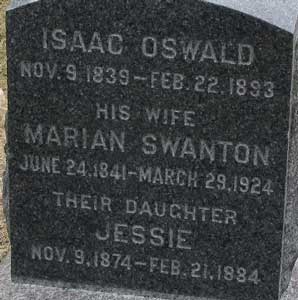
OSWALD, ISAAC (1839-1893). Private, 13th Regiment, New York State Militia, Company D. After Oswald enlisted as a private in 1861, he served with the 13th Regiment of the New York State Militia for its three month activation. He was employed as a bookkeeper in civilian life. His last residence was 446 Jefferson Avenue in Brooklyn where he died after a fall that fractured his skull. Mariane Oswald, his widow, applied for and was granted a pension in 1899, certificate 507,551. Section 59, lot 1719, grave 34.
OTIS, GEORGE KINGMAN (1827-1890). Loyal Union supporter. Originally from Ballston Springs, New York, he was a business agent for the Otis & Gentry Grocers’ Association and was sent to Galveston, Texas, to run their Texas branch. In 1861 at the onset of the Civil War, he remained loyal to the Union and had to make his escape out of Confederate-held country. It was considered very dangerous when he left Texas to make his way back to New York City and arrived at his destination penniless. He changed jobs and became the operations secretary of the Overland Mail Company and was placed in charge of the Smoky Hill division. He ran security operations against rebel raiders and Indians within the state of Tennessee. After the Overland Mail Company was bought out by the Wells Fargo Company, Otis was promoted to general manager of operations and then held a contract to manage the mail in New York City, Brooklyn and Providence, Rhode Island. He retired from the latter job in 1885. His last residence was 111 Taylor Street in Brooklyn. His death was recorded as “cirrhosis of kidney.” Section 194, lot 26967.
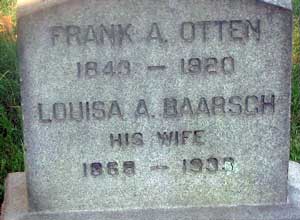
OTTEN, FRANK ALBERT (enlisted as ARDEN, FRANK) (1843-1920). Private, 102nd New York Infantry, Company A. Otten was born in New York City. As per the federal census of 1850 and the 1855 New York State census, Otten lived in New York City with his mother and siblings; in 1855, he lived with his mother and siblings with the family of John Zastrow, his maternal uncle. Starting out as a replacement when he enlisted as Frank Arden, he was one of 100 men from the town of Cold Spring Harbor in Suffolk County that served with the 102nd New York. He enlisted as a private at New York City on April 8, 1864, and mustered immediately into his regiment. As per his muster roll, Otten was a sash-maker who was 5′ 8″ tall with grey eyes, light hair and a fair complexion. Later detached to the Provost Guard, he returned to his regiment and mustered out with his company on July 21, 1865, at Alexandria, Virginia.
As per the 1870 census, he lived with his mother and brother in New York City and worked as a carpenter. The 1880 census notes that he and his brother were boarders at his uncle’s household in New York City; Otten was listed as a sash and blind maker. On September 21, 1885, Otten, 43, and his wife, Louisa Otten, age 17, had a son, Frank Albert Otten, who was born in Manhattan. The census of 1900 reports that the son was a resident of a juvenile asylum.
Remaining active in military affairs, Otten was a member of the James C. Walters Post #641 of the G.A.R. On January 24, 1901, the adjutant general of New York was informed that Otten was just issued a discharge certificate with that surname and that Otten was the soldier who served with the alias “Frank Arden.” Otten’s application for an invalid pension was approved in 1901, certificate 1,051,232.
The 1905 New York State census indicates that Otten, a variety storekeeper, lived in the Bronx with his wife and son, who now lived with his parents. As per the 1910 census, he lived in Huntington, Long Island, with his wife of 26 years, and was a grocery merchant. As per an article in the Long Islander, Otten’s store was the site of a meeting to collect taxes for the town on December 22, 1910. In 1910, the Long Islander of Huntington, New York, reported that Frank Otten Jr., his son, had disappeared and left his wife and their one-year-old child heartbroken. Although Otten did not serve at the Battle of Gettysburg, an article in the Long Islander on October 5, 1917, reports that Otten and another local returned from the Soldiers’ Reunion at Gettysburg where veterans reminisced and told tales of the war. The 1920 census reports that he lived in Huntington with his wife and was a grocery storekeeper. He died at his home in Huntington, New York. His death was attributed to apoplexy. Louisa Augusta Otten, who is interred with him, applied for and received a widow’s pension in 1920, certificate 905,807. As per an article in the Long Islander on March 17, 1933, Louisa A. Otten met a tragic death when she was struck by a car on her way home from church while crossing Jericho Turnpike in Commack; the death was ruled an accident. Section 58, lot 1326.
OTTIWELL, JOHN D. (1827-1900). Lieutenant colonel, 84th Regiment, New York State National Guard; captain, 12th Regiment, New York State Militia, Company D. Ottiwell was born in New York City. The 1855 New York State census reports that he lived in New York City with his wife and four daughters and worked as a tinsmith; on the 1860 census, he was listed as a master metal roofer whose personal estate was valued at $5,000. Active in Republican Party politics, he served on New York City’s Common Council in 1861 and 1862, and in total, held that position for five years; his obituaries in the New York Herald and the New York Daily Tribune, which confirm his Civil War service, note that he was the only Republican elected to that body in 1862. Ottiwell enlisted at New York City as a captain on April 19, 1861, was commissioned into Company D of the 12th New York State Militia, also known as the Tompkins Blues, on May 2, and mustered out at New York City with his company on August 5. As per his obituary in the New York Herald, Ottiwell was elected lieutenant colonel of the 84th Regiment in 1862. His obituary in the New York Daily Tribune reports that the Common Council sent him to the front after the Battle of Gettysburg, Pennsylvania, to look after the interests of New York State troops. Subsequently, Ottiwell served for 100 days in the 84th Regiment’s National Guard in 1864. In 1865, he was chairman of the special committee for President Abraham Lincoln’s funeral procession and obsequies in New York City on April 25, 1865; he signed the formal invitation to that event for guests gathered at noon in the Mayor’s meeting room at City Hall (see below). Ottiwell’s publication, Obsequies of Abraham Lincoln, published in 1866, under the auspices of the New York Common Council, detailed the observance. The 1867 New York City Directory lists him in the furnace business and also as an assessor (one who determines the value of real estate). Ottiwell was a delegate to the Republican Convention in Chicago in 1868 that nominated Ulysses S. Grant for president. In addition, he was a member of Hook and Ladder #9 of the old Volunteer Firemen in New York City.
The 1870 census shows Ottiwell living in New York City with his children; no occupation is listed. His passport application of March 30, 1874, which gives a birth year of 1827 (his obituary says 1825), notes that he was 6′ tall with grey eyes, black hair, dark complexion, large forehead, medium nose, large chin, and oval face. On August 17, 1880, he was awarded Patent No. 231,351, for a fire proof ceiling. As per the census of 1880, he lived in Manhattan with two adult daughters and was still employed in metal roofs. He joined the G.A.R. on May 16, 1882. The New York City Directory for 1888 indicates that he worked in skylights and the 1894 New York City Directory shows that he was in the furnace business. He was a member of the American Geographical Society and the Society of Mechanics and Tradesman. For thirty-five years he worked in the tin and stove business. His last residence was on Lexington Avenue in New York City. His death was attributed to heart trouble following a four-month illness. On October 4, 2013, Ottiwell’s book, Obsequies of Abraham Lincoln, was replicated and made available in paperback. Section 76, lot 2906, grave 8.
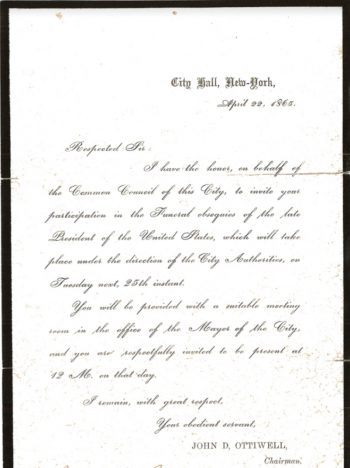
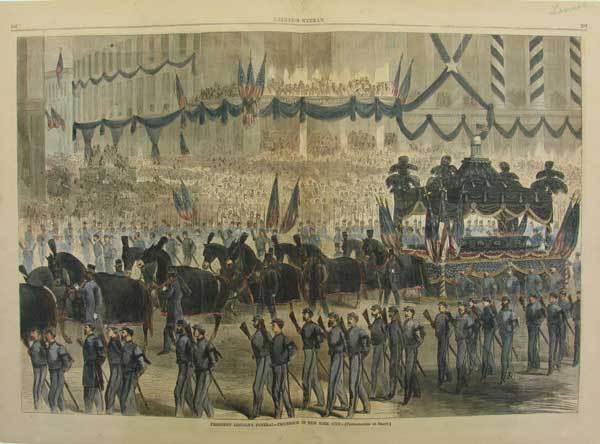
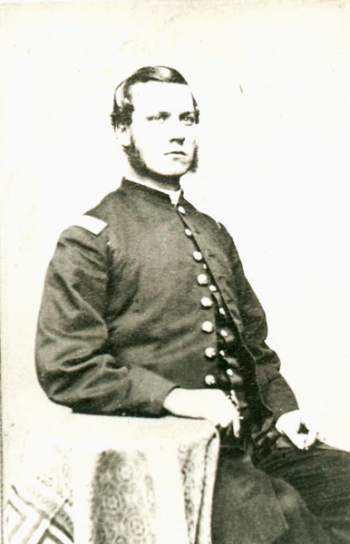
OVERIN (or OVERON), HENRY C. (enlisted as THOMPSON, GEORGE) (1844-1897). First lieutenant, 40th New York Infantry, Companies A, C, E, and B; private, 11th Massachusetts Infantry, Company D. Overin was born in New York City. As per the 1850 federal census and the 1855 New York State census, he lived in New York City with his parents and siblings; his father was a whip-maker. Overin was a student at the New York City Free Academy in 1859. The 1860 census reports that the family relocated to North Brunswick, New Jersey; Overin lived there with his parents and siblings. During the Civil War, Overin enlisted as a private using the alias George Thompson at Greenfield, Massachusetts, on August 6, 1863, as a substitute for Joseph Purrington in the Massachusetts Volunteers, and mustered into Company D of the 11th Massachusetts. According to his muster roll, he was a bartender who was 5′ 10½” tall with gray eyes, light hair, and a light complexion. His muster roll for January-February 1864 showed that he was due a bounty of $25. After being discharged for promotion at Culpepper, Station, Virginia, Overin enlisted as a second lieutenant in the 40th New York at Brandy Station, Virginia, on April 9, 1864. The letter of acceptance from his new captain stated that he had been discharged under the name of George Thompson. He was commissioned into Company A of the 40th New York that day, and was transferred to Company C on July 7, 1864. The muster roll indicates that he was owed pay as a commandant for October 1864. Overin was promoted to first lieutenant on December 1, 1864.
His father wrote to him on December 11 that Helen, his sister, was seriously ill with consumption and that he should ask for a furlough of eight to ten days. (The letter and many of his papers are now held by one of his descendants.) The muster rolls for January and February 1865 noted that he was absent without leave as of January 5 and was awaiting sentence of a general court-martial. On January 27, Lieutenant Colonel M. M. Cannon of the 40th wrote that after Overin went to visit his “dangerously ill” sister in New York City on December 22, he later was seen around Washington, D.C., in early January, having purchased civilian clothing there, and then returned to New York where he and his family resided on Houston Street. Cannon suggested that he be arrested and escorted back to the regiment. Upon being reduced to ranks (private) on March 19, 1865, Overin was transferred to Company E for a brief period and then to Company B. On April 18, 1865, his request was granted to visit City Point, Virginia, for four days to collect papers to settle his account with the government. On June 8, 1865, he returned to Company C with rank and pay and was reinstated as a first lieutenant. Overin mustered out on June 27, 1865, at Washington, D.C.
According to the Episcopal Diocese of New York Church Records, Overin married Mary Baldwin on August 31, 1865, in Manhattan. The 1868 New York City Directory lists him as a whip-maker in his father’s business at 38 East Houston Street. He was active in Republican politics and was at one time a deputy tax commissioner. A successful businessman, he was a liveryman who had a large establishment on Seventh Avenue and 42nd Street in Manhattan that serviced many hotels and clubs. He was also a Freemason.
His marriage was the source of scandal reported in numerous news articles. On September 18, 1878, an article in The New York Times reported that a woman, named “Rosie Brown,” who had married Overin 13 years prior but who had separated from him shortly after their marriage, was at the center of a murder case. Allegedly, Theodore Allen, an acquaintance of Overin’s, shot Edward Malloy, a man who was living with Brown. Overin, who was identified at the coroner’s inquest as a livery-keeper and worker in the tax office, claimed that he had instituted divorce proceedings against Brown for bigamy (she had been married to two ne’er do-wells) and that he had never discussed his marital problems with Allen. A subsequent article in The New York Times on January 3, 1879, described an improbable situation in which Annie M. Holmes of Greenwich Street sued Mr. Overin’s for $220 for the board of Mary E. Overin, after she was released from prison for bigamy. Mary Overin, who allegedly was married to Thomas Parlé, a bank thief known as Pretty Tommy, was acquitted after telling the jury that she only pretended to be married to Parlé, who was about to die, when in effect, it was her sister who was married to the bank thief. Simultaneously, Mary Overin charged her husband with adultery. In 1880, an article in The New York Times discussed his on-going domestic troubles with his notorious wife, he accusing her of bigamy and she accusing him of adultery.
The 1880 census notes that he was single, lived in Manhattan, and was in the livery stable business. The 1883 New York City Directory lists him in the stable business. Overin’s personal life was again aired in the newspapers in an article in the Brooklyn Daily Eagle on January 8, 1888. Apparently, Overin boarded with Angie and Richard Battin in their New York City and country homes for five years. Over time, Mrs. Battin preferred Overin’s company and alleged that her husband’s spending and ill treatment made her destitute and in need of boarders. Angie Battin was seeking a “limited dissolution of their marriage” and Richard Battin was seeking custody of their two children. Mr. Battin poured out his grievances to the court noting among other things, that Overin took his wife out riding and to the Jerome Park races against his will.
Overin’s labor trouble with his livery drivers was the subject of an article in the New York Herald on September 11, 1895. After 30 of his drivers went on strike, he was forced to come to terms with the Liberty Dawn Association of Hack Drivers, led by delegate John F. Maher, and pay his men $14 per week instead of $12 per week. The article went on to say that Overin planned to ask for the indictment of Maher for conspiracy; the pro-union stablemen pledged their leader financial support in fighting the indictment. As per Overin’s death certificate, he was the manager of a stable. His obituary in the New York Daily Tribune, which confirms his Civil War service and his well-known livery business, indicates that his funeral was held at St. Chrysostom’s Chapel. His last residence was 219 West 46th Street in Manhattan. His death was attributed to nephritis. Overin’s obituary states that he was survived by his wife and infant son; the wife, Caroline, and son, Sturtevant, are interred in the same lot. However, an article in the New York Sun on February 24, 1897, notes that marital issues plagued him to the end of his life. That article notes that two women claimed to be entitled to his estate. A second widow, Margaret Overin, claimed that she had married Overin twenty years earlier, separated from him after five years, and in the interim worked to support herself and their children and had lost contact with her husband. When she read of his death in the newspaper, she went to the authorities and learned about the second wife. She then sought help from Police Headquarters. Section 22, lot 7327.
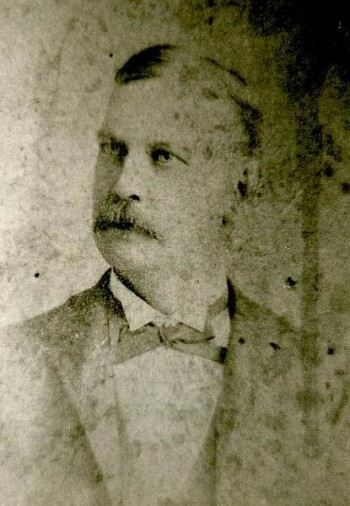
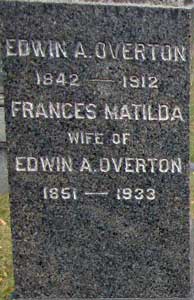
OVERTON, EDWIN AUGUSTUS (1842-1912). Private, 22nd Regiment, New York State National Guard, Company B. Overton was born at 12 Allen Street in New York City. As per the New York State census of 1855, he lived in New York City with his parents and siblings; his father was a broker. During the Civil War, Overton enlisted in 1863 and served with the 22nd Regiment for 30 days.
The 1870 census indicates that he lived in Brooklyn with his parents and siblings and, like his father, was a broker at the Custom House. The family firm of Overton & Co., Custom House brokers located at 12 Broad Street, was an establishment started by Richard Overton, Edwin’s father, in 1839. On May 19, 1875, he married Frances (Fanny) White in Brooklyn. The 1888 New York City Directory lists Overton as a broker. He also was a member of the James Monroe Post #607 of the Grand Army of the Republic. Overton moved to North Plainfield, New Jersey, in 1888, and served on its Board of Education for several years. The 1890 Veterans Census, which interviewed him in North Plainfield, confirms his Civil War service. Overton is listed as a broker in the New York City Directory for 1894. The censuses of 1900 and 1910 report that he was living in North Plainfield with his wife and children and working as a broker. As per his obituaries in the Brooklyn Daily Eagle and the New York Herald, members of his G.A.R. Post were invited to his funeral. Overton’s obituary in the New York Sun, which confirms his Civil War service, notes that he was survived by his wife and five children. He last lived at 91 Rockview Avenue in North Plainfield, New Jersey. His death was attributed to liver cancer. On March 11, 1938, Mrs Edwin A. Overton, his son’s wife, wrote an article in the Brooklyn Daily Eagle about the effects of the blizzard on Monroe Street; she had to pay 75 cents to have her walk plowed because the snow drifted into the backyard, while her sister, who lived across the street, had to pay $5.00 because the snow reached her parlor windows. Section 154, lot 23886.
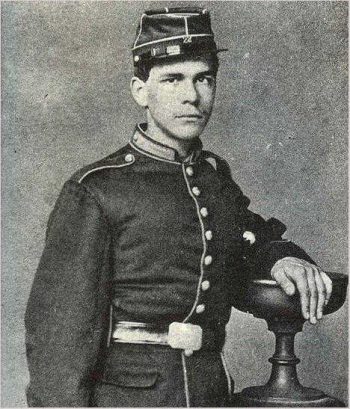
OVERTON, WILLIAM P. (1820-1894). Rank unknown, United States Navy. A native of Middle Island, New York, Overton first practiced medicine in Brooklyn, then moved to Cold Spring Harbor in 1864. He enlisted in the United States Navy at Huntington, New York, on April 30, 1864, for a term of two years. The 1870 census notes that he lived in Huntington, New York, and was a physician whose personal estate was valued at $4,500. His Letter to the Editor, which was published in the New York Herald on December 1, 1879, suggested that the best method of killing criminals painlessly was division of the medulla oblongata; the next best method was administering chloroform. At the time of the 1880 census, he lived in Huntington and worked as a physician. The New York Herald reported on August 13, 1891, that Overton came to the aid of victims who were crushed by a building collapse after a thunderstorm; 14 people were killed and many were injured in that tragic incident. As per his obituaries in the New York Sun and the New York Herald, he was the president of the Queens County Medical Society and served as coroner in Queens County. Overton also served as coroner of Suffolk County for three terms and was active in Republican Party politics. He last lived in Cold Spring Harbor, Long Island. His death was attributed to Bright’s disease. According to his obituary in The Press, he left an estate valued at $50,000. He was listed as an allopathic physician in the Directory of Deceased American Physicians, 1804-1929. An article in The Long Islander on April 18, 1924, reported on a paper presented to the Huntington Historical Society about “Doctors of Medicine Who Have Ministered in Huntington Township.” Overton was recognized for his 28 years practicing in Cold Spring Harbor and his “splendid judgment.” Section 181, lot 11118.
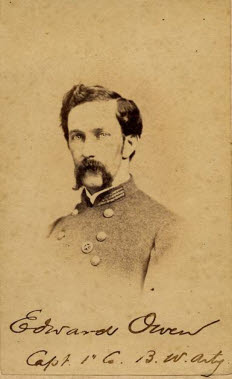
OWEN, EDWARD (1839-1919). Captain, Louisiana Washington Light Artillery, 1st Battalion. Confederate States of America. Owen, who was born in Cincinnati, Ohio, had ancestors whose roots in the South could be traced back to his grandfather, William Miller, who settled in New Orleans in 1798. Miller was appointed United States judge in 1805, participated in raising a company, and participated in the 1814 Battle of New Orleans with General Andrew Jackson.
Edward Owen was a cotton commission merchant in New Orleans when he enlisted there on May 15, 1861, as a first sergeant. The same day, he was commissioned into Louisiana’s Washington Light Artillery, Battalion 1, as a captain. His Confederate States of America payment records for November 1861, which noted that he was a lieutenant, indicate that he was paid $100. Although the details are unknown, he was twice severely wounded in battle. On May 5, 1863, he lost his horses near Fredericksburg, Virginia, and wrote to his colonel asking for $500 compensation in August of that year. During 1863, he was detailed for a short time as acting adjutant on the staff of Colonel J. B. Walton, Chief of Artillery of the First Corps, Army of Northern Virginia. He was taken prisoner of war during the Battle of Chancellorsville and confined at the Old Capital Prisonin Washington, D.C., for two months before he was exchanged. He fought in numerous battles including First and Second Bull Run, Seven Pines, Gaines’ Mills, Malvern Hill, Chancellorsville, Drury’s Bluff, Fredericksburg (all in Virginia); Sharpsburg, Maryland; and Gettysburg, Pennsylvania. His obituary in the New York Herald notes that he fought in close to 40 battles but not the siege of Petersburg.
Although Owen returned to his business after the Civil War, he relocated to New York after his first wife died, was elected to the Cotton Exchange, and became active in business and in the Democratic Party. He married Adelaide Dick in New York City in 1874. As per the 1880 census, he and his wife were boarders living in Manhattan and he was working in the wholesale liquor business. First appointed to a position in the office of the Commissioner of Accounts in 1885, Owen became the chief clerk in that office and was appointed Commissioner of Accounts in New York by the mayor in 1893, 1898 and 1901; that position gave him supervision over all city departments with power to examine all accounts and records.
Owen was a member and officer of the Confederate Camp of New York, an organization that was organized in 1890 and was dedicated to preserving the memories and friendships of fallen comrades in the Confederacy. Among its fund-raisers to help needy Confederate soldiers and sailors and their families was an annual dinner celebrating General Robert E. Lee’s birthday at the Waldorf-Astoria. An article in the New York Herald, “United in Patriotism,” on January 19, 1896, reports that Owen was chairman of the sixth annual dinner of the Confederate Veteran Camp at the St. Denis Hotel. The census of 1900 notes that Owen was a city accountant. On December 20, 1900, The New York Times reported that Owen declared bankruptcy, citing debts from his liquor business. An article in The New York Times on December 29, 1901, reported that Mayor Seth Low reappointed Owen as one of the two Commissioner of Accounts; as required by the City Charter, Owen was the one who was the expert accountant. He was listed as an accountant living in Manhattan in the New York State census of 1905 and the federal census of 1910. As per his obituary in the New York Herald, Owen’s funeral service was held at Stephen Merritt’s chapel at 223 Eighth Avenue, near 21st Street. His last residence was 171 West 95th Street in Manhattan. He died from bronchio-pneumonia. Section L, lot 206, graves 4 and 8.
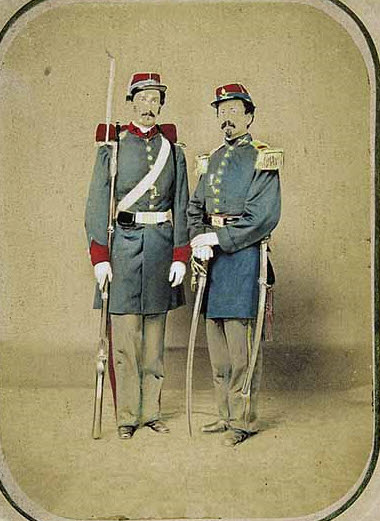
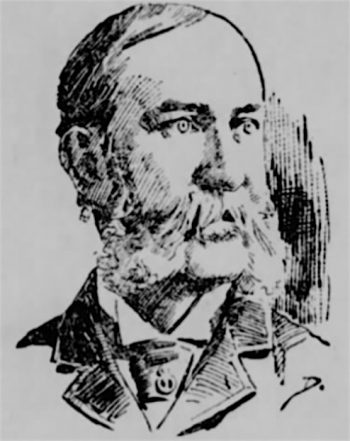

OWEN, EDWARD LIVINGSTON (1843-1923). Private, 22nd Regiment, New York State National Guard, Company H. A New York City native, Owen enlisted as a private on May 28, 1862, at New York City, mustered into the 22nd that day, and mustered out after three months on September 5 at New York City. Although one soldier record indicates service in Company E of the 22nd, his pension index card and another soldier record states that he served in Company H. As per an article in The New York Times on October 7, 1863, Owen was awarded a bachelor of arts degree from the New York Free Academy at a ceremony held at the Academy of Music; he was a member of the Alpha Delta Phi Society at that school. An article in the New York Sun on June 16, 1876, notes that Owen was the treasurer of the Gospel Tent event, a religious gathering held at West 34th Street and Sixth Avenue. As per the 1880 census, he lived on Madison Avenue in New York City with his wife and worked as a lawyer; at that time, he had servants in his home.
Articles in the Buffalo Evening News on August 8, 1882, and the New York Sun on August 9 reported that Owen sued the Reverend Stephen H. Tyng, Jr., the former pastor of the Church of the Holy Trinity and current agent for the Equitable Life Assurance Society in Europe, for $5,000 after their joint stock and bond speculation failed; on August 11, The New York Times reported that Owen had to show more particulars about monies that he expended on behalf of Tyng. The 1888 New York City Directory indicates that Owen was a lawyer at 71 Wall Street. The United States Register of Civil, Military and Naval Service, 1863-1959, notes Owen in its Judicial Section as a United States Commissioner in New York. His first wife died in 1899; he married Georgia Kirby at Armenia, New York, in 1905. The 1903 New York City Directory lists him as a lawyer at 71 Wall Street with the firm of Owen & Sturges. In 1907, he received a pension, certificate 1,137,010. He was the brother of William Henry Owen (see). As per his death certificate, he was married and worked as a lawyer. Owen’s funeral took place at the Holy Trinity Church on Lenox Avenue and West 122nd Street. He last lived at 545 West 125th Street in Manhattan. Section 44, lot 2557.
OWEN, SAMUEL V. (1844-1901). Corporal, 48th New York Infantry, Company H. The 1860 census reports that Owen was living in Brooklyn, his birthplace, with his mother and siblings and was working as a clerk. During the Civil War, he enlisted as a private at Brooklyn and mustered into the 48th New York on April 5, 1864. As per his muster roll, Owen was a clerk who was 5′ 5¾” tall with hazel eyes, brown hair and a fair complexion. He was promoted to corporal on March 1, 1865, and mustered out on September 1, 1865, at Raleigh, North Carolina. The 1870 census indicates that Owen was married with a baby, lived in Brooklyn with his brother-in-law, William Briggs, and worked as a lithographer.
Owen was active in military affairs after the Civil War. As per his obituary in the Brooklyn Daily Eagle, which confirms his Civil War service but incorrectly gives an enlistment date as 1863, Owen organized the Thatford Post #3 of the G.A.R. in 1876. According to an article in the New York Herald on May 28, 1876, the Thatford Post, under its commander Samuel V. Owen, planned to unveil a monument at Green-Wood Cemetery (note: this would be New York City’s Civil War Soldiers Monument on Battle Hill) as part of ongoing Memorial Day services that year; other G.A.R. posts participated in the planned activities including the traditional decoration of the graves of fallen soldiers. The first grave that was scheduled for decoration was that of Clarence D. McKenzie (see); McKenzie’s brother, also a veteran, decorated the grave. At the time of the 1880 census, Owen still lived with his brother-in-law and worked as an engraver. Among the many organizations of which he was a member include the Progressive Council of the American Legion of Honor, Knights of Honor, where he held the position of grand dictator, and the Lincoln Council of the National Provident Union of which he held the position of governor at one time. In 1883, he assisted in the founding of the Rescue Temperance Union. An article in the Brooklyn Daily Eagle on February 20, 1887, noted that the Lincoln Council of the National Provident Union presented its ex-president, Samuel Owen, with a monogrammed gold watch in appreciation of his service. Owen was also active in Republican Party politics in his community. In the 1888 Brooklyn Directory, Owen is listed as an engaver. An article in the Evening Telegram on October 30, 1889, notes that Owen and the Thatford Post participated in the parade accompanying the laying of the cornerstone of the Soldiers’ and Sailors’ Arch at Prospect Park Plaza (Grand Army Plaza) in Brooklyn. The 1897 Brooklyn Directory indicates that he was an engraver. Owen’s service in the Civil War is confirmed by the Veterans’ census of 1890. The 1900 census reports that he lived with his brother-in-law and 11-year-old son in Brooklyn and worked as a bookkeeper.
In addition to his work and other community activities, Owen was a tenor soloist in the quartet at the Greenwood Baptist Church. A widower at the time of his death (his wife died in 1895), his last residence was 457 8th Street in Brooklyn. A minor child, Edward L. Owen, was granted a pension in 1902, certificate 555,436. As per his last will and testament, Owen bequeathed two lots in Jamaica, Queens, to his married son and left the remainder of his real estate and life insurance to his son Edward when he became 25 years old; his brother-in-law, Charles Edward Briggs, was named guardian and executor of his estate. Section 29, lot 10632, graves 13 and 14.
OWEN, WILLIAM HENRY (1841-1921). Private, 7th Regiment, New York State Militia, Company H; assistant paymaster, United States Navy. Owen was born in New York City and was the brother of Edward Livingston Owen (see). Their father, Edward H. Owen, was a prominent admiralty lawyer. William’s obituary in The New York Times indicates that both sides of his family had roots in the United States dating back to the American Revolution; his mother was Jane Augusta Livingston. As per William’s obituary in Mount Vernon’s Daily Argus, he attended the Harrison School at Broadway and 10th Street before entering business with his uncles at age fifteen.
During the Civil War, Owen enlisted at New York City as a private in 1861, served for 30 days with the 7th Regiment, and mustered out with his company at the expiration of his enlistment. The Daily Argus notes that he went with his regiment to Washington, D.C., and was with the first Union troops to occupy Confederate territory. He re-enlisted as a private at New York City on May 25, 1862, returning to Company H of the 7th Regiment’s National Guard, and mustered out with his company at New York City on September 5, 1862. According to the Veterans Schedule of 1890, which confirms his Army service, he then enlisted in the United States Navy as an assistant paymaster on September 30, 1862, and served onboard the USS Arletta until October 8, 1863. Owen’s Navy pension records show that he was assigned to the Mortar Flotilla and also saw service on the William Bacon, Matthew Vassar, and the T.A. Ward. At the time of his enlistment, Owen was a clerk who was 5′ 7½” tall with blue eyes, dark brown hair, dark complexion, and scar on left side of face caused by a cut when he was a child. On January 17, 1865, Owen married Mary Lavinia Brooks in New York City. The Daily Argus notes that Owen often recalled seeing President Abraham Lincoln face to face crossing the long bridge over the Potomac, a memory that recurred when the 7th Regiment formed the honor guard as the slain President was lying in state at New York’s City Hall; Owen coincidentally stood at the head of Lincoln’s casket.
At the time of the 1900 federal census and the 1905 New York State census, Owen lived in Manhattan; his wife died in Woodstock, Vermont, in July 1901. He applied for and received a pension from the Navy in 1911, certificate 40,695; Edward L. Owen, his brother, signed his documents as his lawyer. Anecdotally, his pension records note that his original birth record was noted on his family’s Bible which had been stolen and never recovered. As per his obituary in the New York Tribune, which confirms his Civil War service, he was a partner in the dry goods firm of Brown, Draper & Owen in Manhattan. The obituary notes that he died at the Trinity Rectory, the home of his son, the Reverend William Owen, Jr., who was rector of that church; his funeral was held at Trinity Church in Mount Vernon. His last residence was 324 South 3rd Avenue in Mount Vernon, New York. His death was attributed to kidney disease. Section 32, lot 2969.
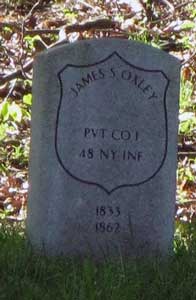
OXLEY, JAMES G. (or S.) (1833-1862). Private, 48th New York Infantry, Company I. A native of Bristol, England, Oxley was an accountant for the A.T. Stewart Dry Goods Company (later Wanamaker’s) and resided at 103 Degraw Street in Brooklyn when he enlisted as a private on November 22, 1861, at New York City. He was 5′ 3½” tall with hazel eyes, brown hair and a light complexion. Four days after his enlistment, he mustered into the 48th New York and according to family lore assisted the colonel of his regiment, possibly as a clerk. He died of typhoid fever on June 8, 1862, at Fort Pulaski, Georgia, the same day that his colonel succumbed to disease there. His widow, Susannah Oxley, applied for and received a pension, certificate 324,496, as did his minor children in 1896, certificate 223,435. Section 35, lot 5275.